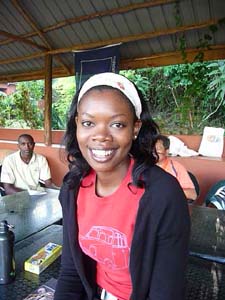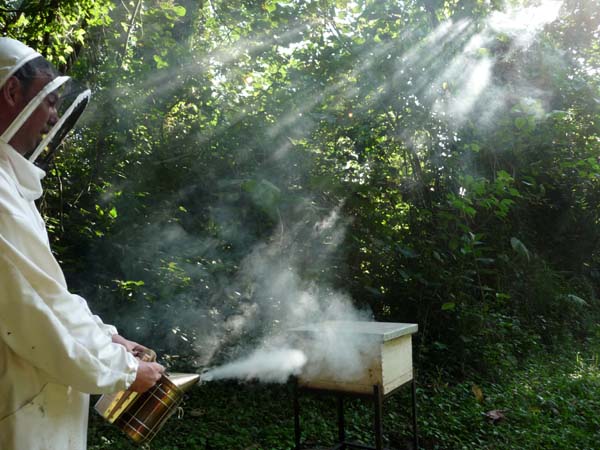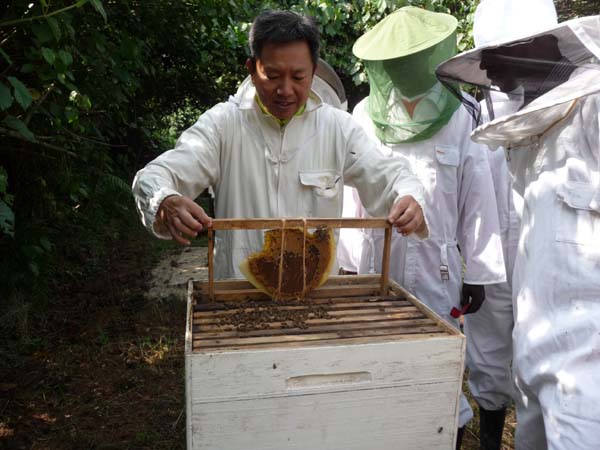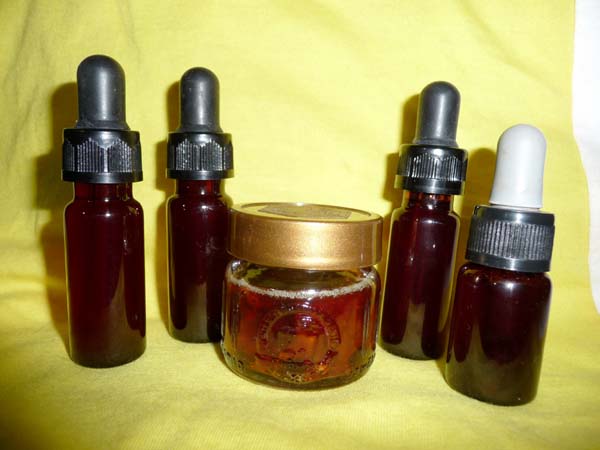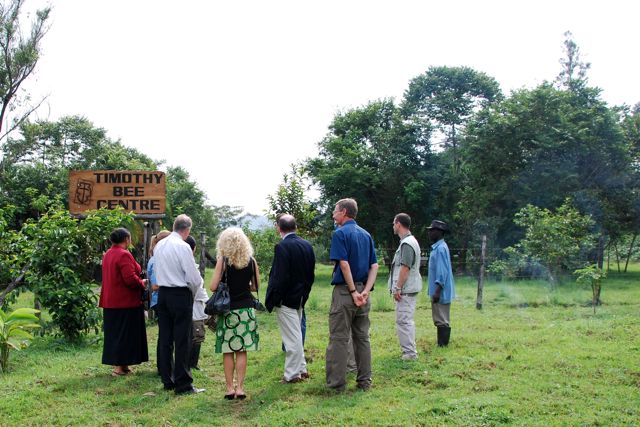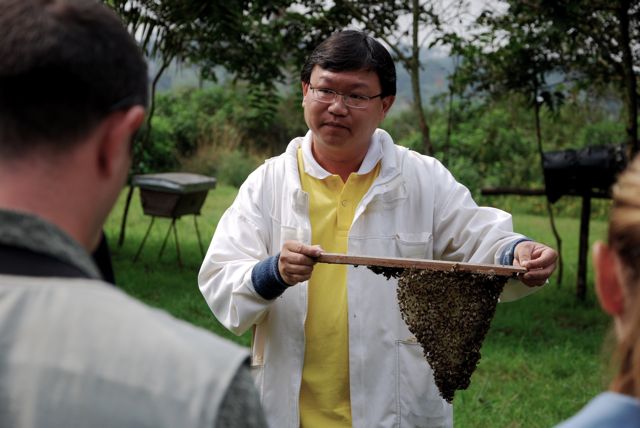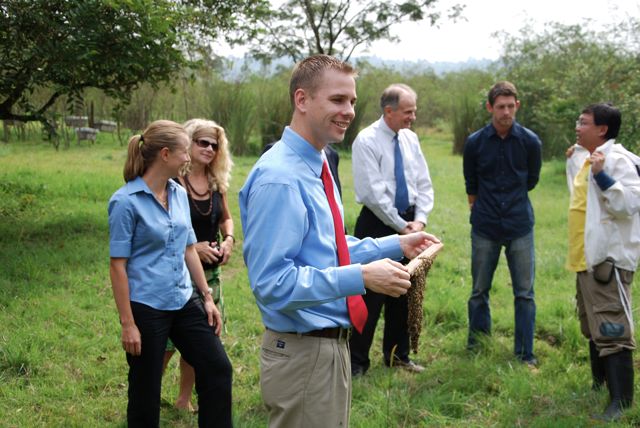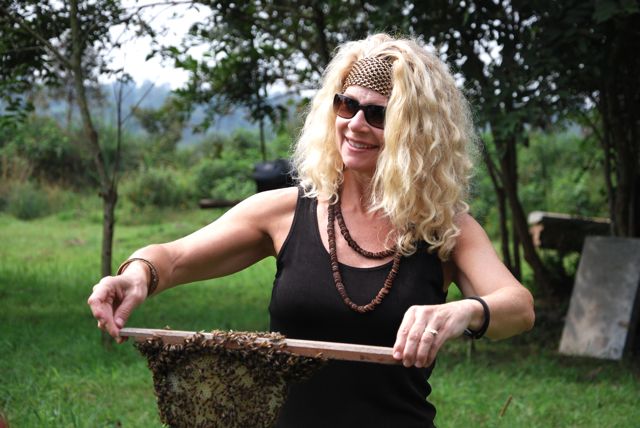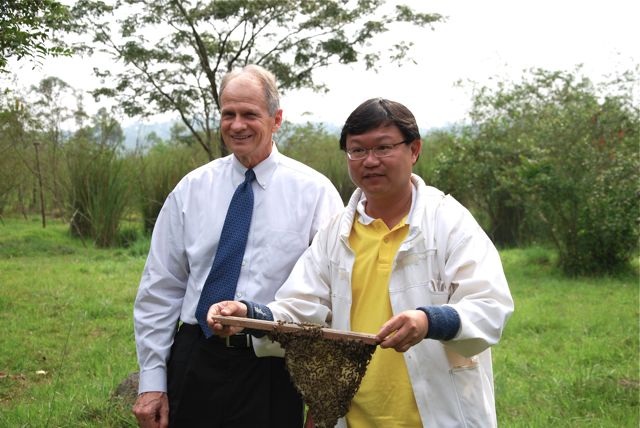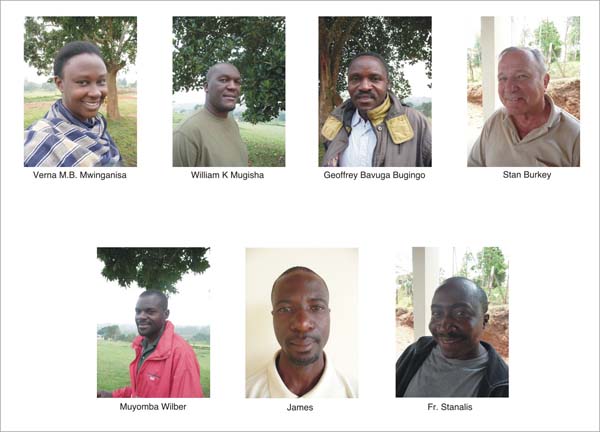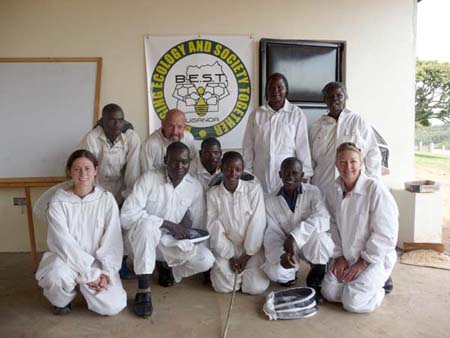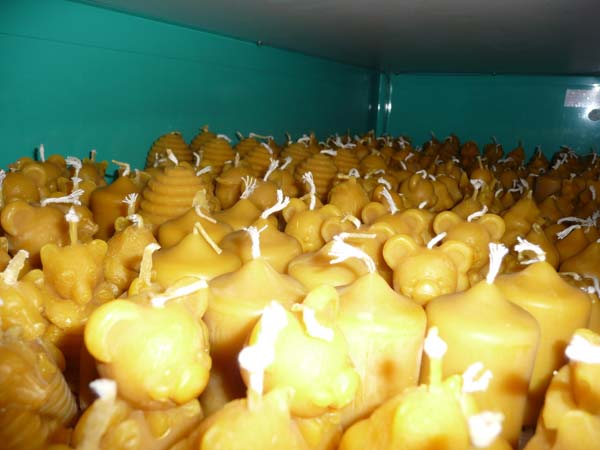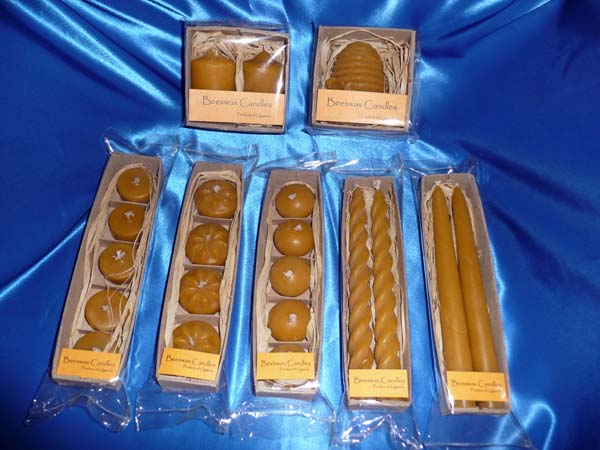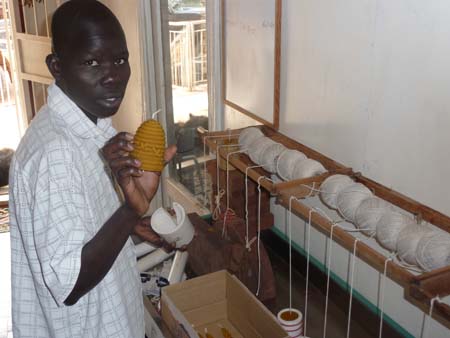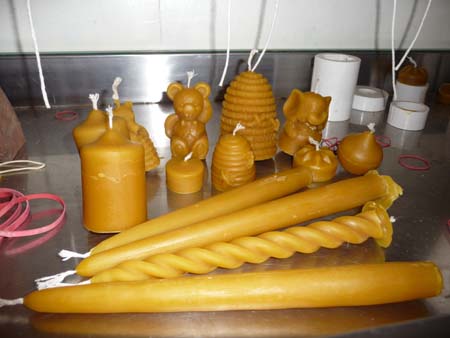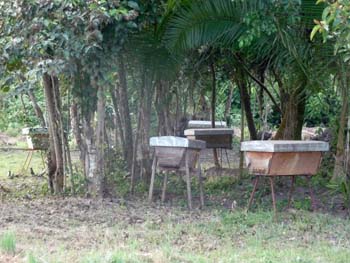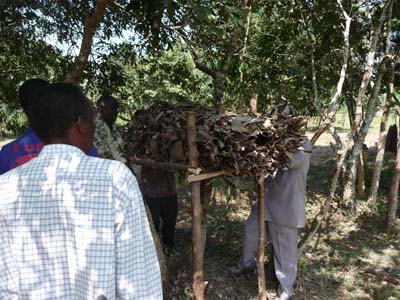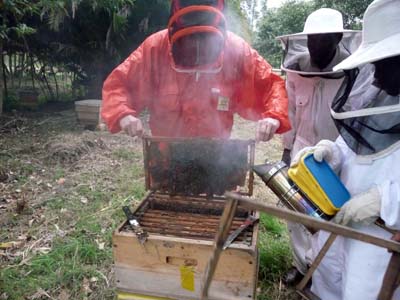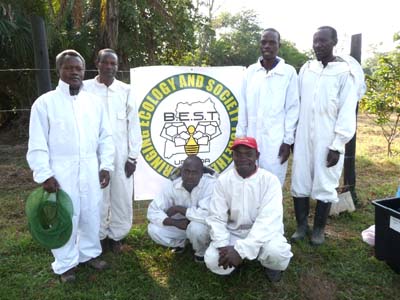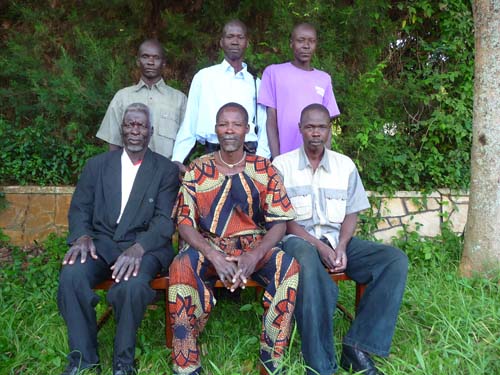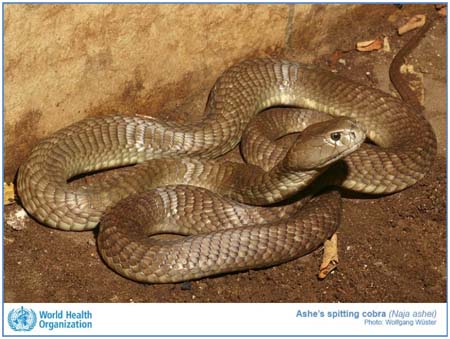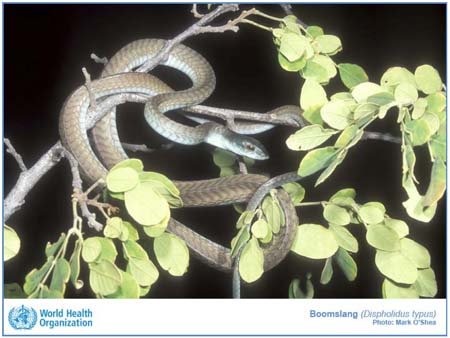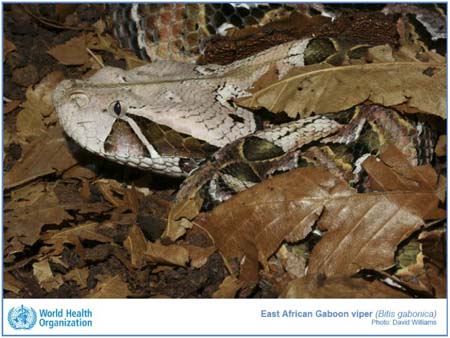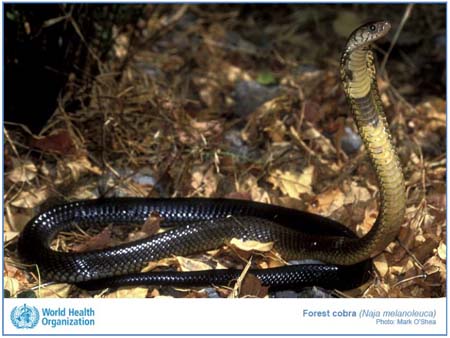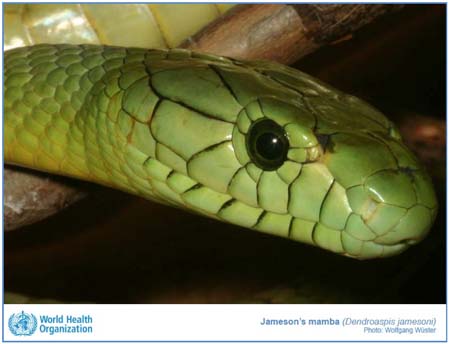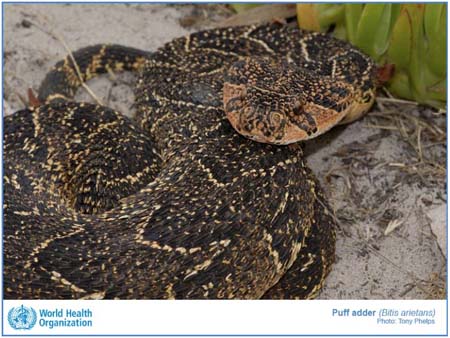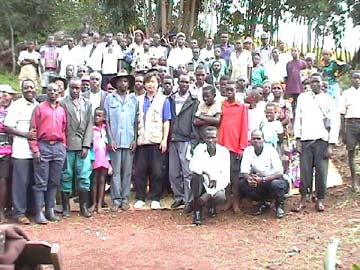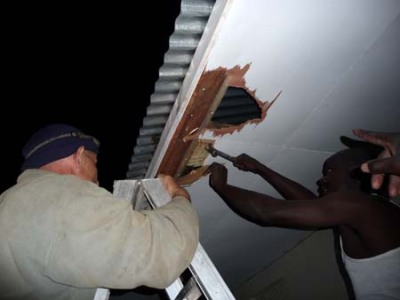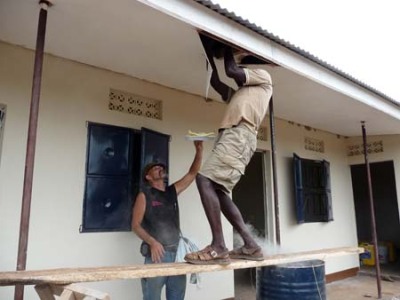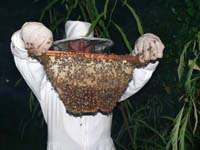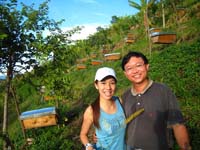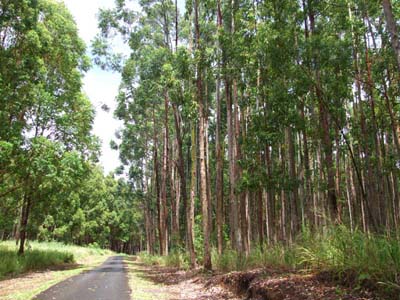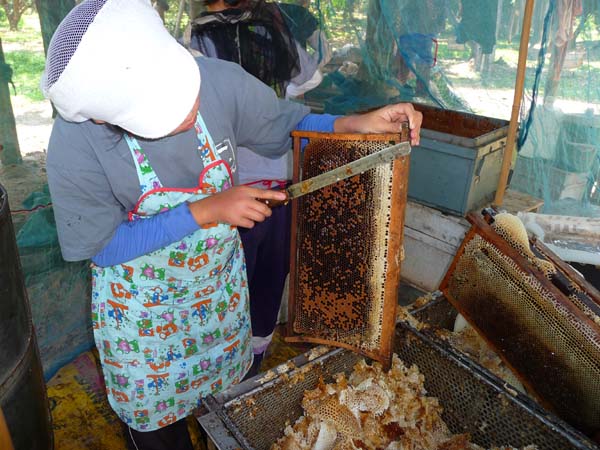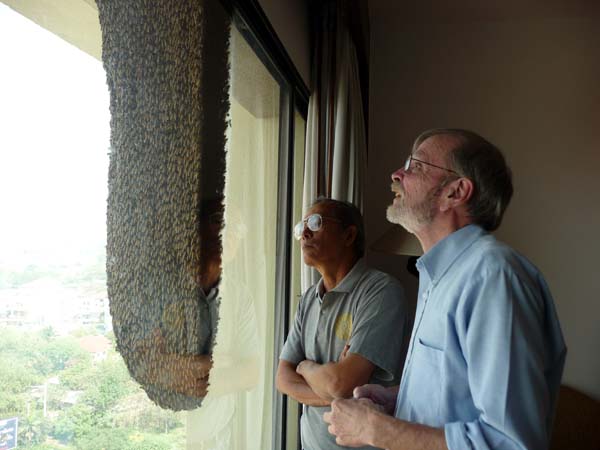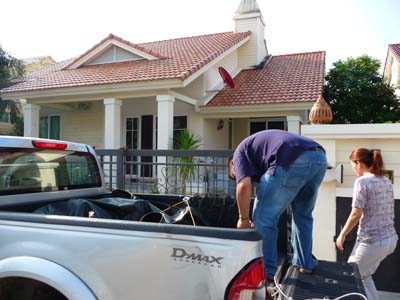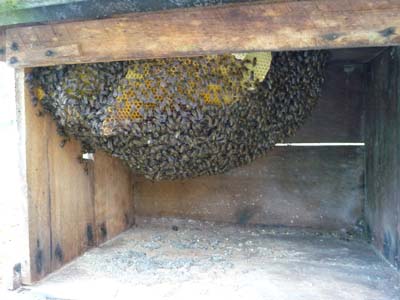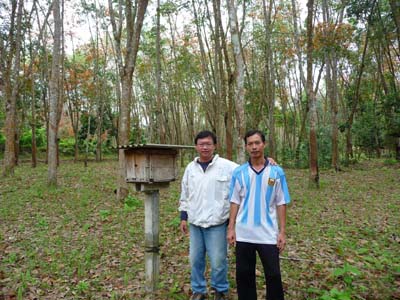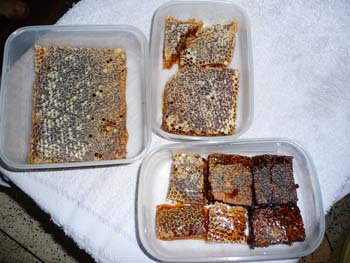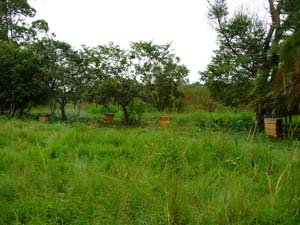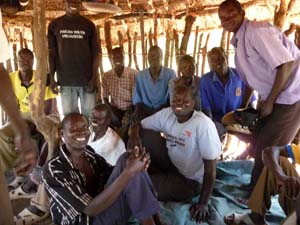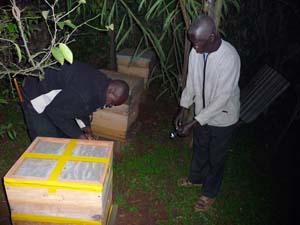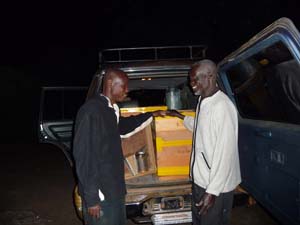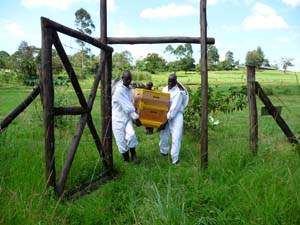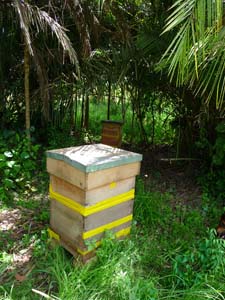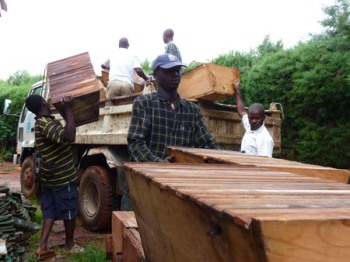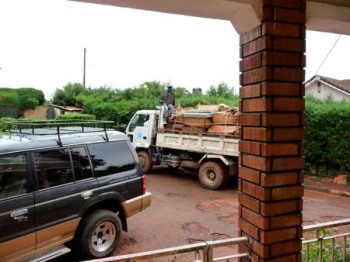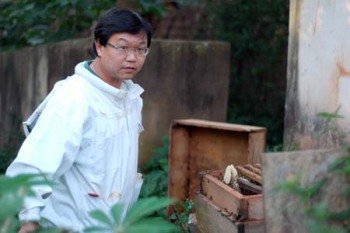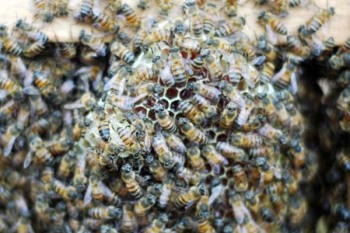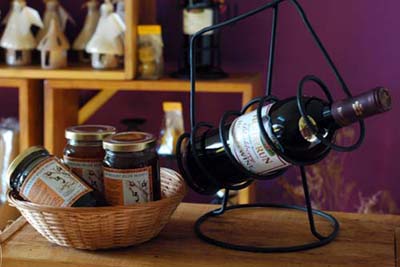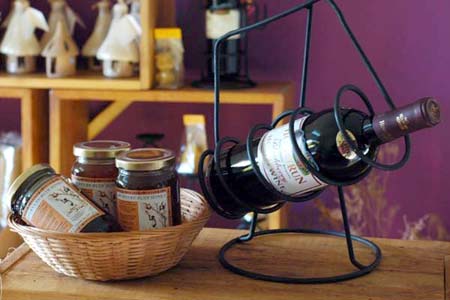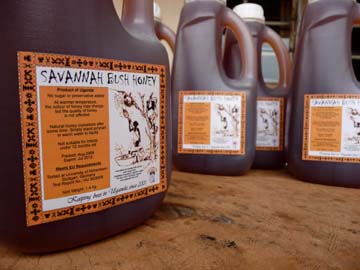Pioneers @ Kajjansi B.E.S.T……………………..
 It was a very successful start for our B.E.S.T. program conducted at our new training centre at Kajjansi. We had yet to name this new centre. Although the setup was not as comprehensive as the one at Timothy Centre, but somehow all the unforeseen happenings made the lessons exciting. One participant accidentally broke a comb and we had to repair in order not to let the brood perished. Another participant was not sensitive to the reaction to one of the colony that he continued to aggrevate them. They had seen how these ladies can be so aggressive when come to defending their nest.
It was a very successful start for our B.E.S.T. program conducted at our new training centre at Kajjansi. We had yet to name this new centre. Although the setup was not as comprehensive as the one at Timothy Centre, but somehow all the unforeseen happenings made the lessons exciting. One participant accidentally broke a comb and we had to repair in order not to let the brood perished. Another participant was not sensitive to the reaction to one of the colony that he continued to aggrevate them. They had seen how these ladies can be so aggressive when come to defending their nest.
All in all, a thumbs up for the group. 🙂
Feedbacks from our first batch of students for Kajjansi!
1. The trainer was very calm, knowledgable and had many years experience with African bees. This created confidence in the students.
2. The training facilities were very comfortable and appropriate. Very easy to get to. it’s convenient.
3. Because it was a small class, I felt that it was well contained and well attended to.
4. Because of the training methods, I felt safe.
5. I enjoyed myself (interaction encouraged)
6) Tea & Coffee (very nice touch)
7. I like the duration of the class. Not too long and not too short. Just right.
8. Most of all, I like that everyday we experienced the beekeeping through practical practices. From that we got our theory.
9. We took care of nature through the methods we learnt, NOT destroy!! – Olivia Murphy
I like the training as it helps me to really realise that beekeeping is not that scary as thought. This training is very systematic and this allows me to learn it step by step, what to do and what not to do.
Having some practical and theory competition at the end of the course really get everybody involved in the learning process of proper beekeeping. – Louis Chua
1. The training had been practical that it makes you used to the bees.
2. Free interaction between the trainer and the trainee.
3. When the trainer is teaching, he is so clear and understandable.
4. The trainer is friendly.
5. Am confident that I have got the relevant training and indeed I have got enough training to establish my bee farm.
6. The whole course has been interesting. – Kasoma Brian
 I like the fact that our training was based on real world experience. Our trainer has a knowledge of African bees which is extensive. The training was “hands on”. Excellent course, excellent trainer. – Michael Murphy
I like the fact that our training was based on real world experience. Our trainer has a knowledge of African bees which is extensive. The training was “hands on”. Excellent course, excellent trainer. – Michael Murphy
I got knowledge about beekeeping
I got to know how to work with bees
I happen to see the queen in a hive and I can differetiate the queen from other bees, the drone and the workerbees
I learnt how to arrange the hive in an apiary
I happen to know beekeeping and how a farmer can improve the colony
I happen to know the process of beekeeping starting from handling – Faisal Muruhura
I like the lesson much
I like the way we do the team work
I like the way we share the idea and skill, the way of explanation
I like the environment
The knowledge we got from the instructor
The way I progress from the lesson everyday
The time the lesson starts and stops – Dramiga Rashid
Show me an African Queen…………………….
Into the third day of the lessons, these future beekeepers got the opportunities to look deeper into what is happening in a hive. They were shown the different occupants and their job roles. As the days moved on, slowly they are getting more confident with their interaction with the African bees. Some of them had already taken off the veil so that they are able to see the bees and the interior of the hive more clearly.
 A comb was selected and placed away from the hive. With that single comb, it told the daily activities in a colony. They managed to see the forager doing the “bee dance”, telling the rest of the foragers where the food source was. Some house bees were busy storing “bee bread” food for the young. They noticed that some of the bees were of bigger size. They were the drones. They knew now that drones do not have a stinger. All of them were so envious of the drone because their job role is simply to eat, procreate and dies.
A comb was selected and placed away from the hive. With that single comb, it told the daily activities in a colony. They managed to see the forager doing the “bee dance”, telling the rest of the foragers where the food source was. Some house bees were busy storing “bee bread” food for the young. They noticed that some of the bees were of bigger size. They were the drones. They knew now that drones do not have a stinger. All of them were so envious of the drone because their job role is simply to eat, procreate and dies.
They also managed to differentiate the cell size of the worker bee and a drone. Alas, there were no emerging queens because it was not the swarming season yet.
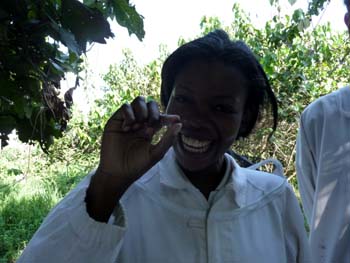
Knowing now that the drone does not have a stinger, Olivia confidently held a drone with her bare hands.
Everyone was eager to see the queen, but I told them we will have to be patient and locate when we bring that comb back first. She was not at that comb which we had brought out.
The training we provide enables a young beekeeper to have a calm environment to learn this trade. They were taught from the very beginning how to interact, to approach a colony without aggressive confrontation. We first create a paradigm shift with the way they view African honeybees. If they were to be treated with respect and gentleness, they will reciprocate.
The sad misconception of African bees being aggressive was eradicated from their minds. They being aggressive are because we made them so. We, human had treated them badly all these while whenever they go honey hunting.
Over the years, Organization embarked on food security programs, only emphasize on giving free bee hives to make good reports. No attention was given on how to manage African bees. Failing to manage them lead to projects abandoned after the project is over. Think of the process, not the outcome. Their aim is to fulfill their personal needs rather than making sure the funds were spent objectively and prudently.
They saw the African Queen…..
B.E.S.T. at Kajjansi…………………….
B.E.S.T. had established another training centre in Uganda. It is located at Kajjansi, Entebbe. A short 15km drive from Kampala enables more people to attend our program without having to be away for a week. Hopefully we can establish more centres all over the country to cater for the people.
This development is part of our plan of setting up a bee keepers club in Kampala. With the feedbacks gathered from our blog response, there is quite a large group of expatriates who are keen to have beekeeping as a hobby.
Our first batch of participants for the KJ (Kajjansi) apiary commenced yesterday. Although the training apiary is not fully operational yet, somehow all the basic setup for handling African bees is already in place. We shall see the centre gets more elaborate like the one at Timothy Centre in due course.
All the participants had heard about the nasty attitude of these ladies. They had never expected that on the second day, they were already told to introduce themselves to these ladies.

Olivia could never imagine that she literally held a comb of bees (bare hands) on her second day of training.
During the training, one of the combs got broken off from the frame. The participants were taught how to salvage the broken comb, especially those that are still containing brood. In normal circumstances, a Ugandan beekeeper would simply throw the whole comb away with the brood intact. In our program, we treasure every single brood. We emphasize on the importance of taking great care of the colony.
Development for B.E.S.T. Program (second course)……………………
 B.E.S.T. program is developing its second course. This course includes value adding such as candles making and propolis production.
B.E.S.T. program is developing its second course. This course includes value adding such as candles making and propolis production.
We are also in the process of developing another training centre nearer to Kampala City. It will be at Kajjansi, Entebbe Road. Once the model farm is established, this training centre will serve those who prefer to have their training done closer to Kampala. In fact the first batch of trainees had already started yesterday.
Production of propolis is underway. For those who had not heard of “Propolis”, I had link the Wikipedia site here.
Bee sting and apitherapy…………………….
Ever wonder what actually happened when a honey bee stings you? The bee stinger is barbed. Just like a fishing hook, it will lodge its sting underneath your skin. When she tried to get away from you, the whole venom segment of the body will tear away from her body, causing her instant death. The venom sac muscles will continue to pump the venom into your body.
Many researcher and scientist are using bee venom as an alternative to cure arthritis and tendonitis. The venom is administered through injection or through bee sting. If the bee sting is used, the apitherapy practitioner will place bees on the skin, typically close to the joints, muscle or other body parts that are having problems.
Somehow I am not in favour of this practice. It is destroying and killing the bees for the benefit of mankind. In order to relieve human suffering, the bees became the victims.
Well this argument can be rebutted again in the name of science. Hopefully we can look into alternative cure.
I would like to thank the bee which had sacrificed for mankind in order to gain this knowledge. I would also like to thank The Department of Entomology of Virginia Tech for sharing this valuable insight of honeybees.
Training video…………………….
 As part of the our on going training program, we have developed this video for our B.E.S.T. program. Participants are supposed to digest what they saw and during discussion, they are supposed to highlight the do’s and don’ts.
As part of the our on going training program, we have developed this video for our B.E.S.T. program. Participants are supposed to digest what they saw and during discussion, they are supposed to highlight the do’s and don’ts.
Are you able to spot the mistakes?
UN alarmed at huge decline in bee numbers…………………….

A huge decline in bee colonies under a multiple onslaught of pests and pollution, urging an international effort to save the pollinators that are vital for food crops. -- PHOTO: AP
GENEVA – THE UN on Thursday expressed alarm at a huge decline in bee colonies under a multiple onslaught of pests and pollution, urging an international effort to save the pollinators that are vital for food crops.
Much of the decline, ranging up to 85 per cent in some areas, is taking place in the industrialised northern hemisphere due to more than a dozen factors, according to a report by the UN’s environmental agency.
They include pesticides, air pollution, a lethal pinhead-sized parasite that only affects bee species in the northern hemisphere, mismanagement of the countryside, the loss of flowering plants and a decline in beekeepers in Europe. ‘
The way humanity manages or mismanages its nature-based assets, including pollinators, will in part define our collective future in the 21st century,’ said UNEP executive director Achim Steiner. ‘
The fact is that of the 100 crop species that provide 90 per cent of the world’s food, over 70 are pollinated by bees,’ he added.
Wild bees and especially honey bee colonies from hives are regarded as the most prolific pollinators of large fields or crops. — AFP Share
Original article – http://www.straitstimes.com/BreakingNews/TechandScience/Story/STIStory_643729.html
US Ambassador’s visit…………………….
During the last training, we had the honour to have the US Ambassador to Uganda, Mr Jerry Lanier, his wife and several staffs from the US Embassy visiting us. Timothy Centre acquired a grant from US Embassy and they were doing a tour to visit projects.
We invited the Ambassador and the team to get up close and personal with african bees. It will be their first time ever. They took the challenge.
First group for 2011…………………….
 17th Jan – 22nd Jan saw the first group of participants for the BEST program for 2011. It was a diversify group because all of them came from various district in Uganda. Even the participants attended were getting more challenging.
17th Jan – 22nd Jan saw the first group of participants for the BEST program for 2011. It was a diversify group because all of them came from various district in Uganda. Even the participants attended were getting more challenging.
Some of them had never kept bees while there is one who is a beekeeper. He is 74 years old. He had been in Uganda for more than 25 years as a development worker introducing sustainable agriculture activities through education on basic accounting and book keeping.
They were prepare to go through the program to overcome the fear in order to embark on the business.
- Participants were taught to overcome the fear by gradually letting them handle colonies of different strength progressively.
This training is a “MUST” for anyone who is willing to keep bees. In this training, I learned how to handle bees in a very gentle way. My fear for bees has reduced – Building a relationship between the beekeeper and the bees is very crucial.
Father Reverend Stanislas is from Togo and currently he is pastoring a church in Lira, Northern Uganda. They had embark on beekeeping for sometime now but he felt that the project has rooms for improvement. He came for the training so that he came equip himself with more knowledge so that he can share it with his fellow folks in Lira. Fr. Stanislas is very hands on himself.
Stan Burkey
The first of importance is how to handle the bees – keeping them calm, non aggressive, how to use smoke to calm and to move the bees. How to handle the bars – all in all, very practical and very hands on. Instructors was very open to discussion, patient, willing to evaluate new ideas. Excellent foundation for further bee management.
Stan Burkey is a private consultant providing a very important component in rural development enterprise – financial planning, book keeping. Many small scale farmers do not know how to manage their earnings, calculate profit and loss. Stan would assist them in getting their books right. 40 years of experience in a few African countries. His contribution had enlighten many such farmers, turning them into entrepreneurs.
I have realised that in order to benefit from beekeeping, one has got to know how to handle the bees and make them your friend instead of enemies. This program teaches how to use the bee tools in order to deal with the bees, not to mistreat them but use the tools to work with the bees.
I so much like the hands on training that we have had which expels out the fear and panic. I aslo like the interactive training whereby you ask and discuss all that you have seen in the apiary.
This training is introductory but really loves a lot of indepth information like how the bee behave and their program in the hive such that you know the time to work with them.
Wilber force is currently working with an NGO is agriculture sustainability. He is embarking on this enterprise so that he can develop his own bee farm at his home. He hopes in the not to far future, he can use his apiary as a model bee farm to help his community to start beekeeping as another source of income to supplement their current earnings.
I liked the creative aspect of the training..Practical, Participatory and Interactive. The training emphasized the establishment of a relationship with the Bees.. at the end of the training all of us the participants were confident enough to drop the veils and the gloves, to get Up-close and passionate with the bees. (theoria cum praxi)
Lesster confidently evaluated The beekeeping Industry (based on his 10 years experience in the industry in Uganda) and gave us the challenges in the industry. The participants discuss the Bee-economics and individual prospective investment plan which he selflessly discusses.
William work as an Information Systems Consultant in his own company where he is the Director. He is also an Associate Consultant at Uganda Management Institute in the Department of Information Technology. He is looking forward to start his Commercial Bee keeping as well as promoting Api-Tourism back home in Kisoro District and to create his own Honey Brand.
Happy New Year!!!…………………….
Wishing all a very happy and prosperous 2011!
Counting down to 2011…………………….
Another year is soon to pass. 2010 saw many exciting happenings in the development. Looking forward to see what’s in store for 2011. Ready……get set……….
Feedback from our participant…………………….
One of our students had written about her experience when she attended our training on her blog. I would like to thank her for the feedback. You can get to see more pictures posted by her here.
My share of pain and experience…………………….
Many had not seen the tough times that I had gone through with the bees here. This was the result for not handling Api Meliferra Scutellata well. I had this picture taken way back in 2001 when I still had not much experience and knowing the aggressiveness of this species. It was after 4 days when the swell had subsided before I could take this picture. I had about 40 stings on my face from this stunt of not respecting and donning my bee suit.
I recalled having my first colony behind my backyard. Every evening when dark fell, I would put on my bee suit, veil and glove. I would light my smoker, grab my hive tool and brush, all ready to face the african bees. All dressed up not knowing what to do and expect.
Every time I tried to open the hive, the whole colony would simply “pour” themselves out of the hive, crawling all over my body. I would use the brush to brush them off, making them even more aggressive. After an hour, I would give up, slammed the cover and literally crushed all the bees that were out.
Come next morning, no one could walk near the hive. They would still be hovering around the hive, attacking any moving creatures that had gone near their habitat.
10 years with these notorious ladies and finally now I am able to interact with them harmoniously. Working with them requires a lot of understanding……. about their behaviour, the environment, our own temperament while handling them. Perseverance had paid off. When was the last time you did something for the first time? 🙂
Flying without wings…………………….
 1st November 2010 – 6th November 2010.
1st November 2010 – 6th November 2010.
An exciting week! We saw participants coming all the way from United States of America and our neighbor, Rwanda. The lesson plans were somehow adjusted to accommodate the inquisitive minds of this group. Everyday they discovered a new frontier about the life of these little insect. Different strokes for different folks.
I was glad that the feedback at the end of the training were very encouraging. Here are some testimonials from this class;

Michael O Doud (USA), "Hands on - very good - very practical & classroom instruction a very good blend of practical that tied well to the sharing of deeper aspects of beekeping. We were challenged to think for ourselves. The exposure to both the traditional bee hive and the modern hive experience".

Ndayishimiye Muhimpundu Georgette (Rwanda), "We did much practice about how to handle bees and understand the different methods applied for different hives. We were also taught to make use of the smoker correctly. The documentary on bee behavior was interesting. The teacher gave us many information and advice".
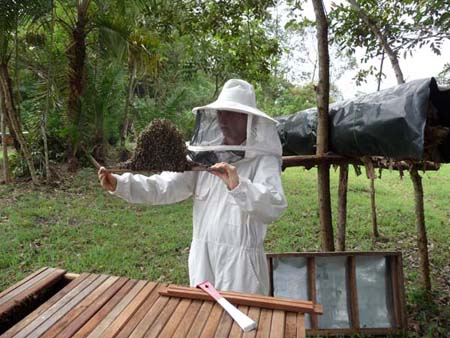
Devon Kuntzman (USA), "The ecology approach to beekeeping. Your ability to help us gain confidence. The hands on approach. Your enthusiasm. I would like it to be longer and spend more time handling the bees. I would be interested in attending more trainings".

Jayne Wick (USA), "The interactive aspect of lab/class "What did you see" - then explain the variety of situations and conditions. Thank you so very much".
The lessons did not end when the classes end. We scheduled Friday evening for a get together to have early dinner followed by a casual session, tackling all those unanswered questions that were still lingering on everybody’s mind.
This is the beginning of a new journey for these new beekeepers. Our program includes a comprehensive tracking system to monitor the performance of every individuals. All trainees were issued with an identification card to monitor their progress.
Charge of the “LIGHT” Brigade…………………….
China has her Terracotta warriors, I have my beeswax candles. 🙂 There is something common between them. They are a gift from Mother Earth. Sharing with the farmers on the values of by-products from honey, they are able to have another source of income.
Previously, the methods the farmers used to extract honey were to squeeze it from the combs with their bare hands, or separating the honey from the wax by boiling the honey at a high temperature. This process will destroy the quality of the honey. After which, they throw the wax away.
With proper education and sensitization, their lives changed. They now know the importance of proper handling of their harvest. Not only they can raise the quality for the honey, they found a new source of income and a ready market.
Another batch going Switzerland…………………….
Past few days were spent running around town, getting all the documents prepared for the shipment. This morning finally saw the shipment ready for flight. The forwarder came on time to load the buckets up. Hopefully it will reach Switzerland safely and on time.
Logistic management in Uganda still has a long way to go. One of my previous shipment, one ton of my honey was left at Entebbe airport for 10 days and nobody notice all the buckets sitting there and going nowhere. Luckily honey is non perishable. If not I will be in deep trouble. My customers were very amazed that how come such things happened. How to compete with the rest of the World if Uganda is not going to look at these issues seriously.
Yesterday I was chatting with the Chief Veterinarian. He is the person that will approve and certify all agriculture export like coffee and in this case, honey. I was surprised when he mentioned that we were the only Company that is exporting honey to Switzerland. He told me that honey going into EU is very difficult because of the stringent quality test required. He was glad that ours are able to meet the EU standards and being exported out. How he wished there were more honey with the same quality in the market.
New range ready for Christmas…………………….
Christmas is round the corner. Creativity plays a major role in keeping on par with market demands. We had just increased our range of beeswax candles for sale. More choices, more sales. 🙂
Here are some history about beeswax candles;
Candles have been used as an artificial light source for an estimated five thousand years. The first candles were made of boiled animal fat (tallow), a substance that when burned gave off heavy smoke, an inconsistent flame, and an acidic odor. It wasn’t until the Middle Ages that candle makers discovered the burning properties of beeswax, the substance secreted by bees to make their honeycombs. Beeswax candles quickly became preferred over tallow candles because when burned, the beeswax candles emitted very little smoke or odor; and beeswax candles burned with more consistency than tallow.
But bees weren’t cultivated. And this rare and prized substance could only be afforded by Europe’s nobility or by the Catholic Church. It later became canon law that candles burned inside a Catholic cathedral must be composed of at least 60 percent beeswax, a law still in effect today.
By the 9th century candle making had become so perfected that the nobility were using beeswax candles to tell the time. Candles were poured and shaped with enough beeswax to burn for exactly 24 hours. The candle maker then marked the candle with 24 lines. The candle’s owner could tell what time of night it was by the section of candle that was burning. In the 13th century, guilds of candle makers began springing up throughout Paris. The next notable innovation for beeswax candles came when guilds started using wicks made of twisted cotton instead of wicks made from rushes, linen, or flax.
The whaling industry provided the dominant fuel source for tallow candles in the 18th century. Sperm whale oil (spermaceti wax) was used more in North American and European candles than other animal fats. But compared to beeswax, the spermaceti candles still smoked more and emitted an unpleasant odor.
Cotton wicks improved next when candle makers began braiding their cotton wicks instead of just twisting them, allowing for a more consistent burn. Using braided cotton wicks is one of the only changes to beeswax candles since their original conception in the middle ages.
For nearly 1500 years, beeswax candles would be considered the cleanest and most pure form of artificial light until the popularization of electricity in the 1900s.
Original article from here.
Lessons turning into action…………………….
 Last Friday morning, we visited some of our trainees to see how far had they gone with our training. It was indeed a very nice surprise when we met with Simon Peter and his family.
Last Friday morning, we visited some of our trainees to see how far had they gone with our training. It was indeed a very nice surprise when we met with Simon Peter and his family.
When we arrived at his place, he was in his working clothes, out in the field. He was happy to see us and was so enthusiastic that we were there. Immediately he led us to one of his shade to show us what he had done – 20 local bee hives! He was in the midst of identifying a suitable plot of land to start his apiary. Simon is also a brick maker. He told us that once he is able to get some income from his selling of his bricks, he will start his apiary.
To me this was very motivational. The effort that all had put in had not gone to waste. Although the results are slow, but there are results from the training. Nothing is more satisfying than to see the participants benefitting from the program. I am proud to have Simon as one of our BEST farmer.
Less is more…………………….
Beeswax is one of the by-product from honey farming. Many bee farmers are not aware that it can be another income generating activity if they were taught to process and value add. One of the main items that can be produced from beeswax are candles. Beeswax candles are well received because of its natural origin. They are not chemically treated like paraffin candles. In fact burning beeswax candles are more environmentally friendly as one does not inhale toxic fumes in comparison to burning paraffin candles. The advantages out weigh the normal paraffin ones.
One of our programs at BEST is to empower the farmers to utilize what is available in honey farming and to teach them about value adding. By collecting empty combs from the hives, they were taught how to convert honey combs to beeswax using whatever they can find locally.
Simple understanding of how things are done do not require expensive equipments. Take for example, a simple solar wax melter are just a few pieces of wood nailed together. Having it painted black to increase the heat absorption rate. Inside are just a few stones to harness the heat , a simple pot cover, with holes drilled acting as a sieve. Under the harsh African sun, the combs will melt through the sieve in a sauce pan, giving them the raw beeswax.
Once the conversion is done from combs to wax, the rest is getting it moulded into different shapes and sizes ready for market. As part of the training program entails entrepreneurship, for those farmers that do not have the facilities to start their own production, we get them involve in the candle making process so that on top of producing honey, they can come to the centre with their beeswax, sell them to us and gradually teach them to use their income to start their own small business. we will help them to acquire moulds from overseas where they have no access to the products.
BEST Program exploring Malaysia………………..
We got acquainted with some Philanthropists from Singapore and we are in the midst of a discussion of bringing our bee education centre project to a development in Malaysia called, “Kampung Temasek“.
Before we begin our input at Kampung Temasek, comes July next year, we will start our feasibility study on how we can establish ourselves as an education centre for those who wants to know more about honeybees and its impact on the environment. Here is the vision of Kampung Temasek;
“The core purpose of Kampung Temasek is to do what cannot and is not done in Singapore by way of educating our parents and kids about nature, the kampong spirit and the reconstitution of our innate Singaporean enterprise-spirit which no longer available in urban Singapore.
What was gained and what was lost? We gained values and skills for industrialisation, white collar jobs and systematic administration. But our loss was creativity, initiatives, imagination, the enterprise spirit and empathy with nature, community and etc.
This Kampung Temasek project is primarily an educational program for the entire family because it enables them to reawaken lost values, attitudes and skills. Starting with confidence building through adventuring and bodily coordination, the enterprise spirit will be exposed to nature and the surrounding communities to better grasp the natural and social ecosystems which sustain all life forms. These knowledge and abilities are challenged through projects which require creativity of the individual and the family.
Special trainers and enablers will be on hand to facilitate the learning process to make it tremendously enjoyable and enlightening. To free the hearts and minds of people to new challenges, unfamiliar situations and new opportunities the 21st century will throw at us since every job, vocation and interest will change.
Striving to provide an experiential enterprising education for the whole family, Kampung Temasek welcomes all enterprising spirits interested in rediscovering the missing ingredient for successful living”.
We find Kampung Temasek very much in line with our BEST program and hopefully by end of 2011, we would have developed a small education centre for the public and at the same time develop a beekeeping industry for the village community around so that it will be another source of income.
Below is the proposed plan for the development of the Bee Centre. The final location has not been decided yet. Please visit Kampung Temasek website for a more detailed insight.
Transferring a colony in a badly rotten hive…………………….
Part of the training program at BEST, we will have a display of a colony hiving in an old rotten bee hive. In order for this colony to survive in this harsh environment, it literally fabricate a layer of wall of propolis to reduce the opening. This is to prevent large predators like rats and snakes to enter the hive.
Many farmers experienced bees absconding and their reason was that the hive was not good enough for them to stay. This is not true. So long as the food supply is there and there are not much predators disturbing the hive, they will stay.
We had adopted this colony so that we can use this colony as training exhibit showing how tough the situation the African honeybees can endure and same time use it to conduct lessons on colony multiplication.
Village folk without social responsibility…………………….
This is one issue we beekeepers have to face, the irresponsibility of farmers around the apiary. During dry season, some of the villagers will take this opportunity to start a fire in order to collect firewood (charcoal) after the forest had burnt out. They don’t care whose land it belongs to.
Yesterday afternoon, our land not far from the apiary was set aflame. Due to the dryness of the trees around, the fire spread quickly and by 6pm, it had moved towards the apiary and Timothy Centre’s guesthouse.
We can’t do much but pray that the wind would change direction and move the fire away from the apiary. The security guards did a fine job by containing the fire. Eventually the fire subsided before midnight and I thought the cool air would not get the glowing flame light up again. At 2am, I heard crackling sound and I went out to take a look. The fire had started once more. Luckily this time round the fire was not near although it was big. I did not capture the earlier fire because my camera was not with me. Below picture was taken at 2am.
BEST Program on 30/08/10 to 04/09/10…………………….
Photos by Lesster Leow, Aug 29, 2010
Vodpod videos no longer available.
Honeybees – Life Cycle…………………….
Wanted to know more about the life cycle of honeybees? Watch the video below from http://www.hilaroad.com.
Training on 5th July – 10th July 2010…………………….
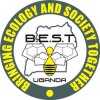 5th July saw the second batch of trainees undergoing the program. The idea of having the interviews for selection before training was prudent because we saw serious farmers who were prepared to pay the price of hard work. If not we will not be able to see the results if committed farmers were not chosen.
5th July saw the second batch of trainees undergoing the program. The idea of having the interviews for selection before training was prudent because we saw serious farmers who were prepared to pay the price of hard work. If not we will not be able to see the results if committed farmers were not chosen.
The 6 days training also saw them spending most of the time in the field, hands-on. By the end of the training, we received very positive feedbacks especially having them recognizing the importance of real field experience rather than classroom lectures of honey farming throughout the course. We had a very interesting participant and we shall talk more about him later in the blog.
Our classes were kept to a maximum size of 12 and below. We do not want classes to be of any larger less it might cause stress to the bees if activities were to be conducted throughout the next 6 days. African bees are well known for its aggressive behaviour. The classes will not meet its objective if the farmers were unable to work on them when they turn aggressive.
The class started with the participants introducing themselves and sharing with all why did they decide to embark on beekeeping. This gesture is common here and I do find it is a good practice. It will somehow enable the participants to interact more freely and to share their experiences as we went along.

Different types of hives were shown to the farmers in order for them to have a better understanding.
Most farmers are still unaware of the different types of bee hives that can be used for honey farming. The course provides the insight of the history of beekeeping, the different methods applied in different parts of the World, the advantages and disadvantages of the various hives used. Most important of all the migration of honey hunting to honey farming.
One of the first topic that we had touched on was sustainable beekeeping. It is pointless if we would just simply teach them about beekeeping without them realizing how to keep the business sustainable. We need to instill in their thoughts that the most productive method is the method that will suit them best, in terms of financial and skills.
Beekeeping is a full time job. We have to change their mindset that beekeeping is not easy and simple. You don’t simply put beehives out in the field and wait for the honey flow season to starts. After which you go and collect the honey and sell. All these have to go. When there are no interaction with the bees, you will see zero results.
When the time comes for harvesting, they would find the colony so aggressive, so much so that instead of harvesting honey, they would destroy and kill all the bees before they can to get to the honey.
The fear of these insects was always there and the only method they knew were to approach them during the night with fire to avoid stings. That was what they were taught from their parents and grand parents. The end results – beautiful honey destroyed and contaminated during harvesting.
They were quite skeptical in the beginning when we told them they will be moving into the apiary in the afternoon. We will work on the bees in broad daylight. Some did not believe it. In order for them to accept the fact that beekeeping can be done during the day, we went down to the apiary and let them have a feel of the bees busy flying in and out of their hives.
The following day, the team started early to begin their basic on apiary management. Previously some were taught that they were supposed to hide their beehives among tall grasses because bees loves to colonized in thick bushes. This is not true. In fact having all the tall grasses and thick bushes would hinder the mobility of the farmer. On top of that, farmers can even be injured or killed by snakes hiding or moving around. Thus we demonstrated why it is important to have a clean neat apiary for easy handling of the hives during apiary management.
Every batch will be taken to task to start an apiary from scratch. We allocated another part of the farm to have them clear the area to prepare the siting of their bee hives. This time round, they will be setting up 2 rattan hives, 4 Kenyan top bars and 1 log hive coming from Gulu.
After which, they were taught to bait all the hives before deploying them out into the field. Baiting is an important process for it will hasten the process of colonization. Many a times, farmers would use cassava flour or honey or even sugar, placed inside the hive to attract the bees. They did not realized that these items will also attract other insects like ants.
Below are some of the shots taken during the 6 days training.

The rattan hive was covered with dried banana leaf as waterproofing. A combination of natural substance which the bees like were introduced to entice a colony to come.
Earlier in this blog, I mentioned that we had an interesting participant. his name is David Sengaali. He was born physically challenged. His left hand was born stunted but his determination of being a good beekeeper was admirable.
David started beekeeping when he was 9 year old and got his skill of honey hunting through his grandparent. He would move around with them and other beekeepers in his village whenever they went for honey hunting. At the tender age of 9, he was fascinated by these insect and wanted to know more. Soon the desire to keep them was so strong that he started to build his own hive and caught bees in places like abandoned ant hill and hollow logs. He would then transfer them into his hives.
Soon village folks around came to know about his passion and they started to buy honey from him. Honey is like medicine to these villagers. With that little source of income, he managed to send himself to school.
25 years had past and now he makes his living by making bee hives, smokers and bee suit for Organizations. His passion had turned into a business for him.
He chanced upon our project 2 months back and was curious when he saw our apiary. He wanted to know more about our operation and approached Karl. When he heard that we are conducting training, he requested to join in so that he is able to increase his knowledge in beekeeping. My interaction with him found out that his knowledge in beekeeping was good. He does have potential in this trade. I will be monitoring him from now and I believe he will be a good candidate to be a future bee trainer under our wing.
Below is a video of him making his own rattan hive during the training.
Photos by Lesster Leow, Aug 7, 2010
Vodpod videos no longer available.
Official Birth of The 1st Beekeeping Training School in Uganda……………………
10 years of struggle, ups and downs, zillions of stings and understanding Uganda’s apiculture had seen us establishing the first school for beekeepers in Uganda. The long awaited beekeeping school had finally arrived! Home base is at TIMOTHY CENTRE, MASAKA.
Our school’s motto – “BEST” program – “BRINGING ECOLOGY AND SOCIETY TOGETHER”, defined our direction and the purpose of the setup of this school. We had seen too many bee farmers keeping bees without sparing a thought for these insects. Most bee farmers in Uganda are mainly honey hunters because not much emphasis were put on the well being of these bees. The long term detrimental effect of the decline of the bee population, unbalancing of the ecosystem was not taken into consideration. It’s about time beekeepers learn to appreciate the existence of the bees and understanding the positive impact when they co-habit alongside with them with the least disruption of their lifestyle. Honey farming can thus be done in a more humane way.
PIONEERS FOR THE “BEST” PROGRAM
First batch of trainees for the program. There were from Gulu district. Class conducted on 10th – 15th January 2010.
FEEDBACKS FROM THE TRAINEES DURING THE COURSE;
“I like the training on transporting bees and the way we can work on bees. My most important lesson was the way the trainer taught us on how we must handle the bees gently in order not to kill them unnecessarily. I have also benefited from the training in three ways – 1) How we must set our apiaries, 2) Working on the bees during day time. 3) How to handle the bees gently.” – Achuman Martin Odong
“What I like about the training was that it had given me technical ways of keeping honeybees. The most important lesson in the training was the calm handling of the bees. The training method was practical. I had benefited from the training a lot because I have discovered many different ways of beekeeping/management of which it will make me go back and make modern change in my bee farm.” – Odoki Thomas –
“Gin ma omiyo aropwony ma pi medo ngec pipito kic. Pi miyo nge kit me kobo kic metero ne ipoto muken. it ma myeo ibed lorem kic. Ki ngec me kwoko poto obed maleng. Ber pa Lapwong nyutu pwonye itic. Anongo ber pwonye iyo meworo, a) weko itoto kic maleng, b) miyo kic pe bedo ger.” – Odong Julius Peter
The second batch of trainees coming for the course will be on 5th July to 10th July 2010. Slowly but surely we can see more bee farmers coming forward wanting to keep bees the proper way.
WHEN THERE ARE BEES, THERE WILL BE HONEY……
You never knew…………………….
Yesterday I received an email from a trading Company in Singapore telling me that they are interested to carry our honey products to be marketed back in my homeland. I guessed they could had gotten my contact either from the web or had read an article somewhere regarding my work as a honey farmer here.
The first few questions she asked were, “How much is your honey? Is your honey pure? Is your honey real? I want your cheapest honey.”
If it was my former self, I would had taken it personally. How can she ask me all these questions without first doing her homework on the industry. She had not even understood what a beekeeper had to go through in order to have that clean jar of honey on the table. I was very surprised with myself that not only was I not offended with these questions thrown at me, and instead replied her with an earnest answer. There are no rights or wrongs with consumers asking that kind of questions. Its just because there are not enough information for the consumers to understand about this industry, especially honey farming in a third world country. I had to thank Violet Oon for that.
Violet shared her experiences as a professional in her work, dealing with all kinds of people from all walks of life. While we were discussing about how we are going to present Uganda honey back to Singapore, we touched on the competitiveness of our honey in comparison with the honey from other countries. My main concern was that Uganda has no regular shipment or flight back to Singapore and the cost of transportation will be an issue. What struck me was when she enlightened me on the different consumers’ needs and want. I began to empathize with the way the lady approached me with her questions. There are products that are meant for general public and there are products that only meant for those who knows and appreciate the values. Its not the end product but what kind of social impact the product had benefited the community during the course of development. I should be the one having to recognize which market is best suitable for my product. Once I can place the path correctly, I will get my direction right.
Coming back to the process of harvesting honey, the many challenges that the farmers had to face had never crossed the mind of the people around the table when that small teaspoon of honey was lifted off the jar. Two of the toughest but deadly challenges faced by the farmers are mentioned below. Personally I had encountered some of the snakes during my life as a bee farmer here. With GOD’s blessing and guidance, that is our only protection from grenades or land mines. You can find more informations and pictures regarding snakes here.
THE HIGH RISKS OF HONEY FARMING IN NORTHERN UGANDA.
1) For the last 22 years, Northern Uganda had been under insurgency by the Lord Resistance Army (LRA). Although the fight had ceased and they had left for Central Africa, there are still a lot of unexploded grenades and land mines lying around. To date, United Nation are still deploying mines experts to detect and detonate land mines. Villagers, especially children were still killed by these mine till today. Our bee farmers are like playing “Russian Roulette”. They will never know when they would step on one.
2) Venomous snakes occur throughout many regions in Uganda and are a threat to the people in the agriculture industry, especially in the rural areas where they are most abundant. Out of more than 3000 species of snakes in the world, some 600 are venomous and over 200 are considered to be medically important. There are two types of categories in venomous snakes. Uganda have 13 species.
CATEGORY 1: Highest medical importance
Definition: Highly venomous snakes that are common or widespread and cause numerous snakebites, resulting in high levels of morbidity, disability or mortality.
CATEGORY 2: Secondary medical importance
Definition: Highly venomous snakes capable of causing morbidity, disability or death, for which exact epidemiological or clinical data may be lacking; and/or are less frequently implicated (due to their activity cycles, behavior, habitat preferences or occurrence in areas remote to large human populations).
Africa has the highest number of venomous snake found. Uganda is no exception. Below are the types of snakes that can be found in Uganda and the chances of the bee farmers facing them during harvesting is high. Bee hives have a warm temperature of 35ºC and snakes love to hide inside the bee hives during raining or cold nights.
To the lady who wanted to import the honey, it’s just a matter of a day’s work, but to the farmers who wanted to sell their honey so that they can provide for their family, it’s a matter of life and death.
A Winning Combination…………………….
Honey harvesting season is over! El Nino had confused the farmers as well as the bees. When it was supposed to rain, it shone and when its time to shine, it was raining cats and dogs. This season the farmers had difficulties in harvesting due to the erratic weather. But still the show must go on. The next few weeks will be consolidation of all the honey buckets from all the parish within the range of 60 kms, All these honey will arrive at the collection centre to be weigh. The farmers will get their payment once we had finalized the quantum.
Now that the honey season is over, we will be looking for other source of income for the villagers. Recently I had been in collaboration with a German friend of mine. He is into Shea butter production for EU market. We will be embarking on a joint co-operation so that our bee farmers and their wives can go into the forest to collect Shea nuts. It would be another good source of income for them. There is a whole demand for Shea butter now. Consumers are slowly appreciating the usefulness of Shea products. Its a good natural ingredient for cosmetic especially for skin.
With the combination of our honey and beeswax and his Shea butter, we will be developing our first range of product – lip balm and moisturizer. Meanwhile our 100% certified Organic Shea butter will be making its way to Asia later part of this year. The product will be available at our Singapore Office.
Bees @ Village of Hope…………………….
Over the weekend, I was invited to Village of Hope, in Masindi to assist in removing a colony of bees that had built its nest inside a rooftop of one of the building. The colony arrived at a bad time because Mike and his team were supposed to have the place fully operational by end of this coming week for inspection. Luckily the colony had been there for only about two weeks and they had not reached its full force yet. If not, it will be more difficult to handle them.
I was glad Mike did not chose the easy way out, which was to get a pest controller to terminate the colony. Life was already tough enough for these bees, we tried not to make it any tougher for them. If we were to take a step back and look at the bigger picture, we were actually intruding into their habitat. Although many felt that we humans are the most superior being amongst animal and insects, we should still stay humbled and learn to live with nature in a more peaceful way. What goes around, comes around.
After dinner, we decided to let the bees get to know us. We had to do this at night for we need to wait for the foragers to return. In case we needed to transfer them down, we would not miss out the foragers.
When Bosco started to pry open the bottom plank of the roof, they started buzzing, showing their unhappiness. My initial plan was to see whether I could avoid using the smoker. Soon from trickling movement, I could sensed that they will pour themselves out within the next few seconds. Immediately we have to move back and activate plan B, using the smoker.
Smoking simulates forest fire. Bees fear forest fire. Smoking the bees is not as simple as it looks. One must fully understand why, when and how to introduce smoke to the bees. It will then be effective.
Too little smoke, there will be no effect on them. Too much smoke, they will turn aggressive. They will start flying in all directions, making it very difficult to contain them.
It took us about 20 minutes before we can proceed with the opening of the bottom panel.
The view was breathtaking! It was indeed a strong colony as they had already built up to 8 combs with some having brood while other having honey stored.
The situation looked calm and we decided that we should not make things ugly by having to dislodge the colony. Moreover, we were not equipped with any empty hive to contain them and to relocate them if we were to bring them down.
So our plan of action was to destroy part of the combs, making them feel that this was no longer a safe place to stay anymore. They would find another location and leave this nest the next morning. Our main objective for this decision was that we do not want any confrontation resulting in casualties on both sides. Patience will make us arrive to an amicable solution.
Comes next morning, we went to observe the bees, they were very still. This shows that they were waiting for the queen’s instruction what to do next. Meanwhile Mike shared with me his plight, that he had a deadline to meet. We do not know know long before this colony will find another location to nest.
So we decided to help them hasten their decision by creating a bigger smoke just below the hive so that they have no choice but to abscond and leave the nest immediately.
Bosco ignited the drum of wood shavings, the smoke and heat started to rise. Within 10 minutes, the queen took flight, stopping at a nearby tree. The whole colony started to follow, forming a large dark cloud. The whole area was buzzing and bees were seen flying in all directions. Those who are not accustomed to this scene will tend to be wary of being attack by them. Usually they would not disturb anyone because they are focusing on joining their queen.
By 10am, everything had quiet down with saw the colony clustering on the tree top. This was where we moved in to clear the remaining combs, painted it with wood varnish demolishing all traces of smells from a previous nest. No other colony will choose this location again.
My first impression of the village when I arrived was a, “YES”! I was impressed with the way things are developing if an orphanage was to take place. The feeling I got was very down to earth, very real. This beautiful family, Mike, Janelle and Jenna, had done a wonderful job, transforming a barren piece of wilderness into a productive, positive haven for these children to move ahead with their lives.
Having such a setup which is very close to the way life should be in Northern Uganda, the orphans are able to grow steadily physically, mentally and spiritually, not having that vast paradigm shift, not taking things for granted. They will learn how to appreciate the changes and opportunities given to them to start life afresh. I can say that the focus right now for the orphans is really their needs and not our wants. The need of a good home, the need of medical attentions, the need for proper education and the need to identify the importance of sustainability. I had seen one too many. Without that portion of self sustainability, projects will not last.
We chatted and had lunch on Sunday before I took off to Gulu to see my bee farmers. We shared many common objectives. Well done! Mike, Janelle and Jenna! 🙂
Honey is simple, keep it simple…………………….
For the past year, my Singaporean friends who had been following my blog had urged me to write about the frequently asked questions on honey. There are so much information on the net concerning honey, having its own findings, rationales and reasons. I would just be duplicating what had already been written and I don’t see the point of repeating it. In Singapore, there are still a lot of consumers who are not sure about the information received, were they facts or myths.
Three of the common myths are;
1) Ants are not attracted to real honey.
Ants, like honeybees, are social insects, when ever they locate a food source, they will go back to its colony to inform the rest of the findings. Honey is simple sugar. It is made up of fructose and glucose. Fructose is fruit sugar. Fruit sugar is sweet. Ants like all things sweet. 🙂
2) One cannot use metal spoons for honey.
After harvesting raw combs from the hives, we are to break the combs and let it drip through fine filters into food grade stainless steel tanks according to safety food standards. Honey are then stored up to more than 3 weeks for settling. Yes, although honey is acidic, but that will create no significant effect whatsoever while using a metallic spoon.
3) Honey must be crystal clear.
Pure unadulterated honey tend to be cloudy due to the presence of pollen spectrum. That constitutes part of the nutritional values in honey. UltraFiltered Honey or UFH honey are crystal clear. Well that boils down to the consumer preference again. Some consumers feel more comfortable taking honey that are perfectly clean and clear. There are also some Countries prefer having their honey pasteurized.
One of the reason why it took me some time before I decide to bring my honey back to my homeland was that now there is growing group of friends that had really understood and appreciate what is real honey, because some had been here and had seen my work and are assured that what they are going to get will be at its purest.
At the same time, they knew that by consuming the honey harvested from our farmers, directly they are assisting them in providing a source of income for their children to go to school and to help alleviate poverty. That jar of honey on my friends’ table are more meaningful rather than pondering whether their honey is pure or not. What they have on their table comes with assurance and these three simple facts are more than enough to quench their doubts;
1) They witnessed the source of the honey
2) They received the test report stating the quality and authenticity
3) They know the beekeeper.
Selling our honey in Europe is far more simpler than in Singapore. The honey eating culture is matured and they know exactly what to look for.
Consuming honey is a simple issue. So long as they are getting from a reliable source, having all the necessary certification and test reports backing up from established institutions. Real honey sells by itself. Our honey going back to Singapore will be as no frill as possible so that consumer will get every single drop of their honey worth.
I guess knowing the source is a sure way of getting what you really want. Consumers are getting more knowledgeable and vigilant with their purchases now because of the internet. There are a whole lot of information out there. Soon consumers will be able to find out the truth. Its just a matter of time.
To summarize it all, what I can say with regards to this issue, whether you are getting the real honey or getting what is worth, here are the simple guidelines;
1) Make sure you get it from reliable source.
2) Knows where the exact location of the honey are produced. (It is best that honey comes from one location and not blended from various destinations)
3) Look at the test report of the honey. The test report is like the birth certificate for that batch of honey.
Well, now is the beginning of the harvesting season and I shall be traveling up to meet my farmers soon. The climate we are experiencing this year is a bit erratic. It should be getting hot by now but somehow we are still having heavy rain. We will have to wait a little while longer before we can start the harvest. We have to work around nature and not against it.
I am glad I have friends coming from all walks of life coming over to visit me. Slowly but surely, by word of mouth, they will be able to share what they had learned from their field experience here.
Honey is simple, it is only made complicated by people.
Introducing Eucalyptus Honey at our boutique…………………….
Finally the test report is out and we are able to introduce a new range for our boutique, Eucalyptus honey.
In our Mellisopalynology report, pollen count shows 95.8% belonging to the Myrtaceae family. Less than 3% consist of Mango, Combretaceae, Anacardiaceae, Senecio-group and Musa. Our Eucalyptus honey is thus considered Monofloral. The enzymes (Diastase) activities detected was found to be much higher than the recommended EU Honey Legislation in Europe. This shows that the honey was filtered raw and natural and has never been heat treated or had gone through UV lights or any forms of heat energy such as microwaves. Diastase, this enzyme is responsible for converting starch to dextrins and sugars and is introduced into the honey by the bees.
The moisture contents of our Eucalyptus Honey falls below 20% and this is one of the most important aspect when buying honey. According to the EU honey standards, honey having more than 20% in moisture content determines the rate of fermentation. Unripe honey harvested are usually having a moisture content of 23% or more. It will taste sourish.
Our Eucalyptus Honey is dark amber and has an intense and persistent peppermint after taste. It crystallizes much faster are usually preferred as an excellent accompaniment to cheeses, pastries and herbal teas.
In Uganda, villagers are often seen using Eucalyptus Honey as a home remedy for mild cough and cold.
Eucalyptus Grandis or E. Grandis is well known in Uganda, being first introduced around 1912. It is commonly planted for fuelwood and poles and is an important source of income for small farmers. As other sources dwindle, E. Grandis is increasingly being recognised as a valuable source of timber too. It is easy to raise from seed and coppices vigorously when cut. Many of the E. Grandis trees in Uganda have hybridised, however, and thus it is important to use only improved seed from tree breeding programmes (mainly in Southern Africa) for commercial plantations here.
In Uganda, E. Grandis is best suited to deep soils in the cooler, moist areas – particularly in the west – around Kabarole and Bushenyi, in the West Nile region and in the south-west (Kabale). On suitable sites and with good management, E. Grandis can grow extremely quickly: Mean Annual Increments of over 50 m3/ha/yr can be achieved in such areas, though an average of 25-35 m3/ha/yr is more likely. Rotations of 8-15 years are expected for the production of sawlogs and large poles.
Bees and Akha Tribal Folks…………………….
As I was ascending up the winding road to meet the Akha hill tribe folks, these thoughts came to my mind. These small little insects have so much to contribute to the society and yet they had always been taken for granted. With everywhere going through urbanization, these little insects are finding it more and more difficult to call a place their own. Many people love honey, but somehow little or no attention is paid to the creator, honeybees.
There are more than 50,000 Akha people up in the hills and are scattered all around. The tribe that I visited was situated in Maechan Province, Patung District, Pabong-ngam, Chiang Rai. All these while, these folks had difficulty in making ends meet. Originally they had a head count of about 300 but many of the young people are slowly heading down to Chiang Rai main town to look for jobs, leaving the older folks trying to eke out a living through agriculture.
Benz came from this village and she was given permission by her parents to be sent to a missionary school at an early age. She had finished her higher education and now she wanted to contribute back to her village.
She told me that many of the young girls had already gone into the flesh trade because of poverty. There was one parent that literally sold their daughter to the flesh industry for Baht 10,000 (S$450). To them the amount is huge.
When Raymond and Koong mentioned my feasibilty trip to North to her, she was very keen to introduce her village to me, to see in what way the village can benefit from keeping bees.
I told her that there are many factors to look into before one can embark on beekeeping. I need to understand the culture of the people and their reception to bees. Many Christian Organizations are helping the village folks and I do not want to be misunderstood as a businessman trying to come in to exploit the people. This is a very sensitive issue. All of us are doing God’s work. Sometimes I just feel that these Organization should have the heart big enough to open up for discussions rather than setting their directions too stringent, not trying to expand their entrepreneurial skills by interacting with others. I fully understood their good intentions of protecting the people from harm, but sustainability is of paramount in order to see them being able to survive without that constant financial help.
Before the visit, we had a brief discussion with an American Pastor that had been in Chiang Mai for 16 years. He told me they had embarked on many projects, ranging from chicken farming, cattle rearing to fish farming. All failed. Sensitizing these villagers to proper farming is good. I believed additional skill like value adding and marketing play an important role as well. I know every Country has its own sets of problems. I have to prepare to face it if I have decided to move ahead with my plans.
Coming back to beekeeping, I had observed the vegetation and I am pretty sure these folks will have no problem to start bee farms around the hills. The situation and scenerio is quite similar to Uganda. What they are lacking is the knowledge in keeping the bees. In fact in our tour, I had seen a few farmers already keeping bees, but that is only meant for their own consumption.
I spoke to one of the farmer and he described to me how he harvest the honey from the hives when it was due. I was tickled when he told me how he had to bear with the stings in order to get to the honey. 🙂
Honey farming contributes to a large portion of poverty alleviation in most part of Third World Countries.
When Raymond and Koong told me about the Akha tribes, It will be a good experience for me too and to share my experience with them. I felt something can be done if they are ready.
Interesting discovery…………………….
I had mixed feelings when I left the apiary in Lampun. I was amazed when I saw how beekeeping was done. European honey farming methods and Asian honey farming methods are completely different. I really appreciate the bee farmer to allow me to have a better insight on honey farming in Thailand.
The term “beekeeping” derived from the way how a bee farmer is supposed to look after the bees, how the farmers is supposed to make sure that the honey is only harvested from combs that are filled and capped with honey, with no signs of broods or larvae. Usually the brood will not survive once they were taken out from the hives. They required the constant temperature the worker bees provide. The incubation period is very vital for the young brood to develop properly. I wonder is this one of the causes nowadays where bees are less resilient to viruses?
When I exchanged notes with Professor Burgett while having lunch, he shared the same sentiments. For those who are in the beekeeping industry will know what we meant.

Comb harvested with brood still intact. Honey portion are not capped yet, meaning that the honey is still unripe.
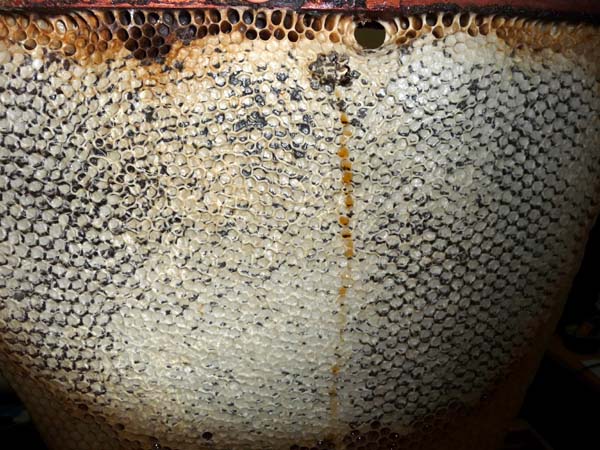
Honey harvested from our farm in Uganda. Only fully completed capped honey combs are harvested for consumption. No traces of brood is present in order to meet EU requirement.
After witnessing the difference, somehow I felt very proud of my farmers. They had done a wonderful job by providing such good quality honey for the world to taste. Uganda beekeeping is so many years behind modern honey farming Countries but yet, they can fulfill the EU requirements. A pat on their shoulders.
A beautiful welcome gift from Chiang Mai…………………….
Driving from the South to the North took us 2 days. We had to time our route so as not to get ourselves caught in the unrest in Bangkok if there are any.
 Something interesting happened and you will never believe it! By the time we reached Chiang Mai, we were dead tired. We stayed at GardenView Hotel in Chiang Mai. When I opened up the door to my room, I saw something huge hanging outside the window. As I walked closer to see, I was very shocked and surprised to see a colony for the Himalayan bee, (Api Dorsata is the largest honey bee species in the World), clinging on to the window.
Something interesting happened and you will never believe it! By the time we reached Chiang Mai, we were dead tired. We stayed at GardenView Hotel in Chiang Mai. When I opened up the door to my room, I saw something huge hanging outside the window. As I walked closer to see, I was very shocked and surprised to see a colony for the Himalayan bee, (Api Dorsata is the largest honey bee species in the World), clinging on to the window.
The sight was breathtaking! One can never have the opportunity to view this species so up close. Api dorsata are very aggressive when disturbed. Imagine the size is about the size of your pinky.
I really could not believe my eyes! It was as if Chiang Mai is welcoming me with such a special gift, a gift from God!
I could not resist. I had to open up the window, (8th floor), to get a better, clearer picture for my collections. It was indeed a priced photo.
One interesting behaviours about this species is that every afternoon, they will leave the nest in a swarm and start to defecate. During the Vietnam war, American Soldiers who were on their tour of duty experienced it and initially thought it was a chemical warfare deployed by the Viet Cong. It was known as “The Yellow Rain”.
I had the honor to see them up close and personal. 🙂
Beekeeping in Southern Thailand…………………….
Arrived in Bangkok on 23rd Feb and immediately on the following morning, Raymond and his wife, Koong, drove me down South to visit bee farmers to have a better understanding on how they keep Apis cerena. We arrived in a district called ‘Chum Porn” and there is a large community involved in honey farming. According to the village folks, they are called “The Cave Bees”.
During my last trip, I had gathered some information from Professor Michael Burgett, that Apis cerenas were kept successfully in the South and it will help tremendously if we are able to transfer the knowledge to Chiang Mai, Chiang Rai and Chiang Dao. So far the species has still not yet been use widely in the North. One advantage of using these species is that it is easily available and to capture them, literally cost nothing. This might be a good way for the rural farmers to start beekeeping rather than having to buy colonies.
When I went to open up a colony, I can feel the calmness in them and they were not as aggressive as the African siblings.
Came back on the following day and tomorrow we will be heading up North to Lampang, Chiang Mai and Chiang Dao. Long journey again. Gotta sleep early. 🙂
Partners in Singapore for Uganda Honey……………………
After landing back in Singapore and after a week of break, my marketing drive began. The first stop was meeting up with Violet to finalize the way forward in promoting Uganda Honey into the market. The discussion went well and soon Singaporeans will be able to buy our honey at all Violet Oon’s outlet.
One small harvest before heading home…………………….
I am excited to make my trip back home tomorrow. I guess you can say it’s occupational hazard. I must visit at least a colony before I leave. Meanwhile, I harvested some comb honey to be brought back to Singapore for my family members and friends to see what is ‘REAL RAW HONEY”.
There are so many marketing hypes about raw honey and its health benefits in the market but actually, does one really knows what does that mean or are they simply buying the label? Well hopefully this time round my family and friends are able to gain more insight of what is real raw honey harvested fresh from the farm.
Yes, although I am keen to push my honey into the Asia market after having served the European market for the last 5 years, I would also like my consumer friends to fully understand the benefit of eating honey, and not turning it into some kind of miracle wonder medicine that can cure everything. If I were to do that, I am doing a disservice to my fellow Singaporeans.
Hopefully this small talk will enable more to appreciate the existence of the honey bees and how it contribute to mankind. At least you will know that the next spoonful of honey you take, no bees were sacrificed.
“BEST” Program @ Timothy Centre…………………….
BEEKEEPING for ECOLOGICAL, SOCIAL and TECHNOLOGICAL program. This is what BEST stands for.
Finally, all the hives are in place at Timothy Centre and the apiary is now fully operational. Last week we saw the first team of farmers embarking on our “BEST” program. They will be the first batch of trainees to be appointed as trainers when the program goes full throttle.
These 6 bee masters had been working with us for the last 3 years in the North and they were selected for their performance and dedication to beekeeping.
With the grant given by US Embassy, we make sure that only genuine bee farmer who has the desire to embark on beekeeping as a source of income generating activity, will be given priority to benefit from it. In this way, the grant would then be utilized properly and productively. Years and years of research, trial and errors from Organizations had shown that if you were to ask any farmer who wants to go into beekeeping, every single farmer would raise their hands. All they wanted is just to ride on the free benefit, get whatever equipments they can get hold of, after which whether they make use of it or not, nobody cares. Worst case scenario, they would sell it just to make a little bit of money to go to town and buy themselves a beer.
Here at Timothy Centre, we are going to make that difference. There will be no free rides but only genuine, dedicated beekeepers who are willing to part take in our “Entrepreneurial Skills” program. These farmers have to fully understand the whole idea of being a self employed rather than a recipient. On performance based, interviews and on site visits to their existing operations will be conducted before enrollment. The farmers will be accessed based on our findings. This way, we will then be able to maintain the quality in all areas. Without neglecting the social base (social), our 26 modules allow some would-be farmers who are serious and wants to try out on honey farming, can still enroll in our basic beekeeping courses. In order not to let these farmers taking this opportunity for granted, and due to their low income capacity, they have to play their part by contributing back to the Centre in kinds, for example collecting of firewoods for the school, assist in maintaining the model apiary occasionally and others not in monetary form.

Participants were trained at my place to overcome the fear of African Honey Bees before proceeding to TC. (Do not try this at home)
“BEST” program emphasis not only on honey production alone. The three other aspects are equally important. Farmers will be trained on how to handle African bees effectively and gently, overcoming the fear of its natural aggressiveness. This is the first hurdle in becoming a good beekeeper. A beekeeper will not be considered a good beekeeper if the harvest consist of a bucket filled with dead bees. That is honey hunting.
The fundamental understanding is to accept the philosophy on how to work with nature rather than against it. (ecological)
Through generations and knowledge passed from one farmer to another, most of the harvesting were done in the night because of the fear, because of its aggressiveness. Very few beekeepers had seen the inside of a beehive in broad daylight. It will be a paradigm shift for them with this kind of practice.
During our last day before we round up the lessons, we had our evaluation. I came to realized that one of them who had attended my talk 3 years ago did not believe that we can harvest or perform any activities during the day. These short 6 days of training had totally changed his views on beekeeping methods.
The other interesting findings for them was that beekeeping is done in a very clean clear environment. All these while, they were taught that bee hives should be hidden amongst tall bushes, away from prying eyes. This has got to change. What they saw at the Centre was a total culture shock to them. Beehives were neatly arranged in order within a few meters apart from each other, not like theirs which some were placed a few hundred meters away.
Our “BEST” program encompasses different types of beehives, from traditional log hives to KTB to modern langstroth. Farmers will be able to identify the different method of beekeeping and can choose which form of beekeeping best suit them. With this direction, smooth transition from traditional beekeeping to modern methods of beekeeping (technological) will still be in place.
The first lesson for them was apiary management. They did a fine job converting the whole apiary into a bees’ paradise.
Among the 6, 3 of them were their first time out of GULU. After the insurgency, they had never visited other parts of Uganda. I could see the excitement and joy in their eyes that they are going to bring back lots of stories for their children when they return.
We believe all work and no play makes Jack a dull boy. In recognition for their great effort in making it all the way from GULU, we decided to let them enjoy a piece of their homeland, Uganda. 🙂
Timothy Centre in co-operation with Little Honey Man. 🙂
First good news of the year!…………………….
The year started with a very good news from US Embassy. Usually they have funds for farmers to embark on agriculture projects and they were looking for good partners to work with in order for the farmers to benefit from such funds. We were identified as a potential partner and they came to interview us. Few days back we received an email saying that they were pleased with the findings and had identified us as one of the partner they intend to work together. Below was part of the mail that was sent to us and we felt honored to be selected;
” It is my pleasure to inform you that you have been approved as recipients of this year’s Ambassador’s Special Self-Help Fund grant! We are looking forward to partnering with you in your various income-generating activities reaching under-served and under-privileged people throughout Uganda. It is our hope that together we truly will make a difference in these communities………
…………….Looking forward to a wonderful partnership with each of our grantees. We have chosen 7 projects with the hope of finalizing one or two more. Congratulations! This is very competitive (9 projects out of 100 applicants!) and you have stood out as doing exceptional work in your communities.
Please do not hesitate to contact me.
Yours in development,…………………..
Dawn P. Conklin
Small Grants Coordinator
US Embassy – Kampala, Uganda “
Having gotten this motivating mail, it really made my day. Now the farmers are able to move an extra mile with the support.
I could see the trend of large Organization co-operating with private social enterprises. I should say this is the way to go because we as social entrepreneurs, we have mindset focused to succeed in order achieve our goals which we had set out to do. We developed the whole value chain from training to harvesting to refining to packing and export.
I had seen many projects failed because their emphasis stop short at providing equipments to farmers. They did not realize the importance of a sound training program where farmers were taught how to handle the bees properly in order to attain quality honey. Sadly the rest of the process were not properly established thus putting many farmers in limbo. They produced poor quality honey which are not acceptable to the world market.
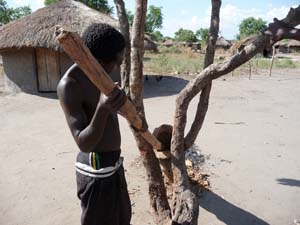
Farmers are trained to utilize whatever is available on the ground. Basic beekeeping is the way to go.
This created a bottleneck where abundant of low quality honey were produced but going nowhere. Disappointment and dissatisfaction grows and soon farmers dropped the idea completely and start to look for other avenues.

Most of our honey going EU comes from these traditional hives. The honey harvested still meets EU honey legislations.
All these things can be fine tuned if the Organization involved are prepared to pay more attention not only on fulfilling their equipment distribution objective but also on the environmental impact, where wrong methods of beekeeping were applied, causing millions of bees to perish in the process.
We would like to thank US Embassy for having confidence in us. 🙂
New Year, New Ideas…………………….
Happy New Year everyone! In this brand new year, let me start off with something that is close to everyone’s heart, or I should say stomach – FOOD! Occasionally I will be introducing honey related recipe for those who are keen in trying to use honey on their dish. For a start, here is one Asian dish, Cantonese Shredded Beef.
Stir-fry over high heat cooks food quickly while sealing in all the flavour. In this recipe, the beef is cooked until crisp and sweet. Blossom honey counteract the spiciness of the pepper while harmonizing with the sweetness of the carrots. The dish is best served with plain boiled rice to absorb the honey juices.
This recipe is meant for a serving of 4.
2½ tbsp sesame oil
3 cloves garlic, chopped
12 baby carrots (about 375g), cut into 5cm strips
1½ tbsp soy sauce
6 tbsp blossom honey
¾ tsp chilli powder or cayenne pepper
500g beef fillet, cut into thin strips 5cm long
¼ tsp salt
In a wok or non-stick frying pan, heat the oil until hot. Add the garlic and cook until it is just turning golden.
Add the carrots with 2 teaspoons of soy sauce, 1 tablespoon of honey and ¼ teaspoon of chilli powder or cayenne pepper and stir fry for 2-3 minutes until the carrots are just starting to soften.
Add the beef with the remainder of the soy sauce, honey, chilli powder or cayenne pepper and the salt. Stir-fry for a further 5-7 minutes until the beef is a dark golden brown and slightly crispy and the carrots are caramelized. Serve immediately.
Contribution to World Food Chain…………………….
Julius and Martin are my bee masters from Gulu. My work of sharing the importance of having to produce quality honey does not stop at the village. I will make effort to bring the leaders down occasionally to Kampala to show and explain why we need to pursue excellence in what we are doing.
Before I came, keeping bees in the the North is just to produce enough honey for their own consumption and many did not realized that it can be an income generating activity.
Bringing them to the city will somehow motivate them to realize the potential and many aspect of moving forward after being in insurgency for so many year, thinking that there is little or no hope for their future generations.
I had been working with them for three years now and I do feel their sense of wanting to progress. What amazed me was the speed in which they picked up the skill from honey hunting to honey farming.

Proud to have their honey certified, packed and sold at the largest supermarket (Shoprite) in Kampala. At the same time, in support of an Orphanage (Kids of Africa) paying forward for the future generations.
Once that is achieved, they are able to pat themselves on their shoulders and showing the world that they can also be part of the world food chain by producing high quality honey for the world to embrace.
Their trip to the city this time included a short session on how to transfer bees from one location to another. According to them, this is the first time in Uganda beekeeping history that they are able to learn how to do that. They had done short distance transfer but never in their life ever thought that we can transfer bees 120km apart.
They will be part of the team to transfer the colonies to Timothy Centre within the next 3 weeks. It seems that we are unable to fulfill my planned schedule of completing the task before Christmas. Anyhow, the show must go on.
Timothy Centre will be the FIRST-ONE-OF-ITS-KIND apiary in Uganda where bee farmers coming for training will be able to understand the different kinds and methods of beekeeping around the world. They will then be able to fully understand what sort of method best suits them. Rather than just having to listen to others, always thinking that the most expensive and modern hives is the way to go.
For the time being hives that are going to be deployed at the Centre will be the Traditional Log Hives, Rattan Hives, Kenyan Top Bars and the Langstroths. Timothy Centre will also serves as an information Centre where NGOs who have beekeeping projects, wanting to introduce it as part of their curriculum, to have a better understanding on the way forward in initiating it to their farmers.
Modernization of beekeeping industry in the North takes time. The current situation requires a lot of effort, especially apiary management. Why the need for these farmers to learn how to relocate hives is that most of the hives were placed in an awkward position where it is so difficult to work on them safely and gently. Others had their beehives located too far apart between every hives, making it time consuming for farmers to work on them.

Taking a quick break to have a shot to show their fellow village folks back home of their adventure. 🙂
Our findings for the honey industry here is this – there is no such thing as whether modern bee hives produces better, higher quality honey compared to traditional log hives. All nectar collected from the bees and being converted to honey are good quality honey. It is the process of how the farmer approach the hive, handle the bees and extracting the combs. Most of our honey harvested are from the traditional log hives and yet they are able to meet EU honey legislations.
The other misconception about beekeeping in Uganda is that farmers were being told that it is one of the simplest form of income generating activity. They simply place a modern beehive on a tree, just wait for the bees to come and deposit honey and collect them during harvesting season. So many quickly jump onto the band wagon but later realized that it was not true, Finally giving it up totally losing their hard earned money to those who sold them the idea.
Too many hypes on modernization but little emphasis on sustainability.
Julius, 68 and Martin, 45, and the other 300 farmers that I am working with do faced many obstacles but somehow we are determined to face them one at a time.
The only time we failed is the last time we tried. We have not try the last time yet. 🙂
Back to work…………………….
Three weeks with Jonathan passed by in a flash. Today we started to pick up where we had left off before he came. It rained quite a bit in the morning and our schedule was delayed a little. All the hives were soaking wet when we loaded them on the truck. Hopefully we are able to complete our work before Christmas and spend a relaxing festive season. Francis will be escorting the bee hives to Timothy Centre. Tomorrow he is getting married.
Up close and personal……………………
Really appreciate Jonathan for taking time to come from Singapore to capture moments of my work in still life. He had also shared a lot on the art of photography. Its all about inspiration and being able to capture the feeling and moment there and then. The final challenge is to capture the African bees closeup at 5pm. The timing for opening up beehives during the day is crucial. The weather must be cool in order for the bees to stay calm.
Come next week, when Jonathan leaves for Singapore, we will resume the transfer of bee from Kampala to Timothy Centre at Masaka.
Honey and Photography, coming together in perfect harmony…………………….

Jonathan did a fabulous shot on the comb honey we brought to Dr. Anne's tea party. His photography skill brought out the distinct character of the comb of liquid gold.
Jonathan Wong, bringing out the beauty of my honey…………………….
Jonathan Wong, a professional photographer from Singapore came and did some product shoots for my advertising campaign. The results was astonishing! He had brought out the beauty of my work. Below are my two favorite shots!
Little angels taking flight…………………….
Here are the first batch of angels made out of 100% natural beeswax, getting ready to take their maiden flight to Singapore.
Our little angel candles are all natural substance made by bees in contrast to paraffin, a chemical byproduct of the oil industry. The burning characteristics of beeswax candles differ from those of paraffin. A beeswax candle flame has a “warmer,” more yellowish appearance than that of paraffin, and the color of the flame may vary depending on the season in which the wax was harvested. It gets its aroma from the honey and pollen packed into each honeycomb cell. Every individual angel is created from our hand poured mold.
Beeswax candles burn with the spectrum of the sun emitting a brighter, longer burning flame. It is a well established fact that while burning, beeswax candles naturally emit negative ions which clean the air and invigorate the body.
Beeswax is produced in the bee hive of honey bees of the genus Apis. Worker bees (the females) have eight wax-producing mirror glands on the inner sides of the sternites (the ventral shield or plate of each segment of the body) on abdominal segments 4 to 7. The size of these wax glands depends on the age of the worker and after daily flights begin these glands gradually atrophy. The new wax scales are initially glass-clear and colorless, becoming opaque after mastication by the worker bee. The wax of honeycomb is nearly white, but becomes progressively more yellow or brown by incorporation of pollen oils and propolis. The wax scales are about 3 millimetres (0.12 in) across and 0.1 millimetres (0.0039 in) thick, and about 1100 are required to make a gram of wax. Typically, for a honey bee keeper, 10 pounds of honey yields 1 pound of wax.
Western honey bees use beeswax to build honeycomb cells in which their young are raised and honey and pollen are stored. For the wax-making bees to secrete wax, the ambient temperature in the hive has to be 33 to 36 °C (91 to 97 °F). To produce their wax, bees must consume about eight times as much honey by mass. It is estimated that bees fly 150,000 miles, roughly six times around the earth, to yield one pound of beeswax (530,000 km/kg). When beekeepers extract the honey, they cut off the wax caps from each honeycomb cell with an uncapping knife or machine. Its color varies from nearly white to brownish, but most often a shade of yellow, depending on purity and the type of flowers gathered by the bees. Wax from the brood comb of the honey bee hive tends to be darker than wax from the honeycomb. Impurities accumulate more quickly in the brood comb. Due to the impurities, the wax has to be rendered before further use. The leftovers are called slumgum.
Beeswax is also used commercially to make cosmetics and pharmaceuticals including bone wax (cosmetics and pharmaceuticals account for 60% of total consumption), in polishing materials (particularly shoe polish and furniture polish) and as a component of modelling waxes. It is commonly used during the assembly of pool tables to fill the screw holes and the seams between the slates. Squeezebox makers use beeswax as an adhesive, when blended with pine rosin, to attach reed plates to the structure inside an squeezebox. Beeswax candles are preferred in most Eastern Orthodox churches because they burn cleanly, with little or no wax dripping down the sides and little visible smoke. Beeswax is also prescribed as the material (or at least a significant part of the material) for the Paschal candle (“Easter Candle”) and is recommended for other candles used in the liturgy of the Roman Catholic Church.
It is also used as a coating for cheese, to protect the food as it ages. While some cheese-makers have replaced it with plastic, many still use beeswax in order to avoid any unpleasant flavors that may result from plastic. As a food additive, beeswax is known as E901 (glazing agent)
Beeswax has been used since ancient times; traces of it were found in the paintings in the Lascaux cave and in Egyptian mummies. Egyptians used it in shipbuilding as well. In the Roman period, beeswax was used as waterproofing agent for painted walls and as a medium for the Fayum mummy portraits. Nations subjugated by Rome sometimes paid tribute or taxes in beeswax. In the Middle Ages beeswax was considered valuable enough to become a form of currency.
First squadron takes off………………..
After a week of rest, we went back to organize our first colony of bees for our relocation exercise. The process is tedious but it is better to be safe than sorry. The colony will be placed in a bee proof cage for double protection. The bee hive itself will also be sealed except a small portion which we will only cover it with wire mesh.
All this were being done the night before because we have to wait for the foragers to come back. If not, when morning comes, some of the foragers will be left behind. We try to relocate the whole colony if possible.
It will be a slow two and a half hours drive from Kampala to Masaka. Setting off at 5am, hopefully with no traffic jams, reaching Timothy Centre by 9am. We have to abide to the schedule in order that we can quickly release the bees when we reach our destination.
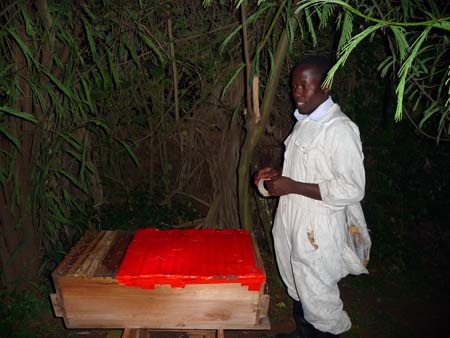
Francis preparing to seal the top part of the hive.

Any gap that is more than 49mm must be sealed. If not the bees will escape.

We leave the last few bars free from tapes so that the bees can breathe through it. A fine wire mesh is place instead.
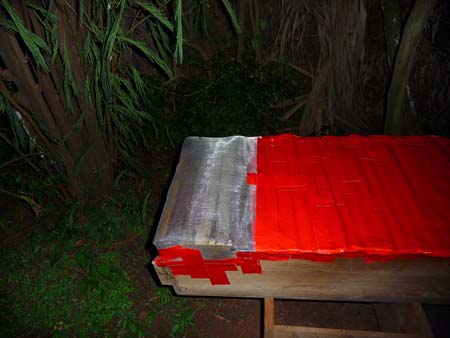
Wire mesh neatly covering the last few bars.

Francis is pleased that the whole process was done without aggravating the bees.

The colony is going to spend a night in my car.
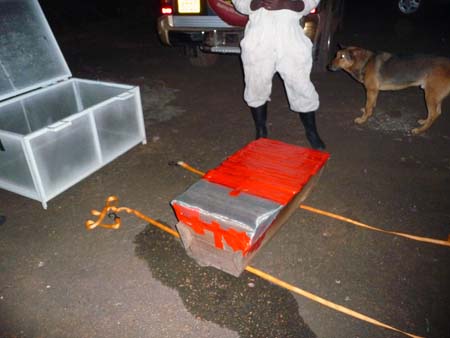
Preparing to place the beehive inside the bee-proof cage.
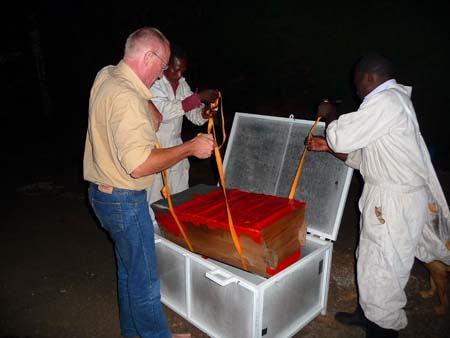
Helmut came to assist while I was taking all these photos.

Colony safely inside my car.
The next morning at 5am, the journey starts. Luckily there wasn’t much traffic. We need to get out of town as quickly as possible just in case if there were any mishap or the bees somehow escape. We will then be endangering the public. Keeping our fingers crossed all the way.
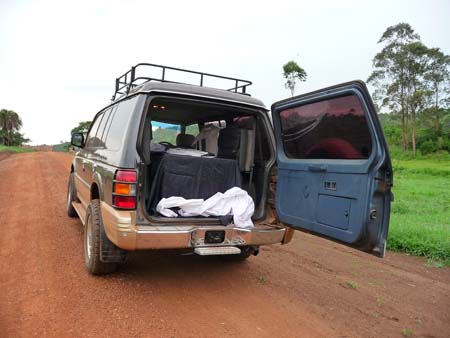
Reached Timothy Centre around 9am. A black cloth is used to cover the cage to reduce the light from entering the hive. The bees will then be less active, less stressed.

Karl and his staffs were already waiting for our arrival.
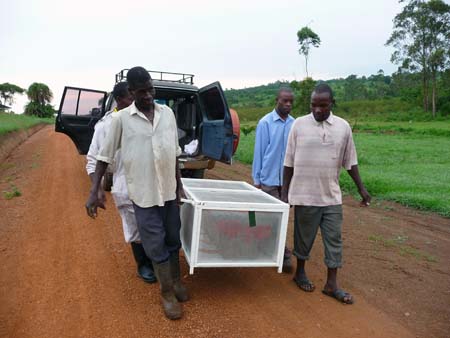
The bees are going to their new home.

Timothy Centre bees haven.

The colony has reached its destination.

The bees are settling in for now.
Due to the aggressive nature of Api Mellifera Scutellata, relocation of these species, great care must be taken. One cannot slack in any of the procedure. Most important aspect when handling these bees is to minimize as much direct contact with them. The amount of smoke being introduced must be just right. Many Ugandan bee farmers are still having this idea of smoking too much, thus aggravating and suffocating the bees.
Once the bees are settled in, we release them. As for the tapes, we shall remove them as we perform our regular hive management. We do not remove all the tapes immediately, if not we will experience the whole colony pouring out, attacking anything within 100m.
Pre-flight check……………………
Soon all these colonies will be transported to Masaka to start the training school. We will have to do a pre flight check to make sure we understood the stucture of each and every one of the hive in order to have them transferred without any hiccups.
Helmut and I had been keeping bees in our garden in Kampala for the last 5 years. All good things must come to an end. He will be leaving Uganda soon and I had taken the task to adopt his bees. They will come in very handy for my training school at Timothy Centre, Masaka.
An amazing friend that shared the same passion as I. In fact his experience in beekeeping is far more greater than mine for he has been based in a few African countries and he had always kept bees.
 We went to his place around 1930hrs but the rain had disrupted our schedule and finally at around 2045hrs, the sky managed to clear and we proceed on with the checks.
We went to his place around 1930hrs but the rain had disrupted our schedule and finally at around 2045hrs, the sky managed to clear and we proceed on with the checks.
Francis, my bee master, who will be the overall in charge of the training school at Timothy’s, assisted me is making my rounds. So far I am very pleased with his performance and the way he handles the bees, although there are still a lot of rooms for improvement.
We had to perform our harvest and check in the night because Kampala is really saturated with residential housing and we do not want the bees to disturb the neighbors should they became cranky.
 There are a few reasons why we are harvesting some of the honey. When the volume of honey is reduced, the bees tend to be less aggressive because they have less honey to protect. At the same time, the hive will be much lighter for us to transport them for the 2 hrs drive.
There are a few reasons why we are harvesting some of the honey. When the volume of honey is reduced, the bees tend to be less aggressive because they have less honey to protect. At the same time, the hive will be much lighter for us to transport them for the 2 hrs drive.
Comb honey is highly in demand from the expatriates community because these “Muzungus” honey lover truly appreciate fresh comb honey harvested directly from the hive without going through any processing or filtering. Honey at its purest!
The fascinating sight of having the comb honey being sliced open, watching the liquid gold flowing down onto the platter, makes one wonder how nature had created such a small yet dynamic insect, being able to interact socially amongst themselves without a single conflict.
 Although African bees are known to be very aggressive, they still do display its gentle side, provided we as human being, listen to them more attentively and not try to force ourselves onto them during harvesting. No clashes will occur.
Although African bees are known to be very aggressive, they still do display its gentle side, provided we as human being, listen to them more attentively and not try to force ourselves onto them during harvesting. No clashes will occur.
The result – beautiful comb honey with little or no casualties on both parties. Many a times, bee farmers are too eager to get the job done. They approached the hive with only one intention…… get the honey and go. Whether the bees are destroy or not is secondary. To me, this is honey hunting.
Whenever I harvest honey, I will always think of this friend of mine, Joanna Yue. We used to play squash together back home occasionally and will always share her squash knowledge when we played. She once told me that in order to play good squash, I have to think of the process, not the outcome. So long as I set the process right, the outcome will be right.
 In beekeeping, I applied the same principle. Thinking of the process, by listening to the bees, observing their movement and behaviour, practicing patience. The outcome will see me having that beautiful comb taken out from the hive successfully with little or no stings. I do feel a great sense of achievement whenever I managed to harvest fresh comb honey without agitating the bees and being able to keep their temperament at bay.
In beekeeping, I applied the same principle. Thinking of the process, by listening to the bees, observing their movement and behaviour, practicing patience. The outcome will see me having that beautiful comb taken out from the hive successfully with little or no stings. I do feel a great sense of achievement whenever I managed to harvest fresh comb honey without agitating the bees and being able to keep their temperament at bay.
Every road that we walked, every path that we take, it’s all about life experiences. It’s just a matter of how one adapt to the situation and environment. Even a young lady nearly half my age, had shared a life skill so valuable that I am applying it now.
Anyone care to have a taste of fresh comb honey? 🙂
Routine tour of duty at Shoprite…………………….

Shoprite staff arranging honey shelf.
Today I went to Shoprite to check on my stocks. Ramadan (the Shoprite staff in the picture), told me that although things are moving slowly, it is still moving. My honey is slowly gaining ground with shoppers there. By the way, Shoprite Checkers is an established South African supermarket based in most parts of Africa Continent. Most of the customers that are using my honey are mainly Expatriates and Somalian. They are more particular about the quality.
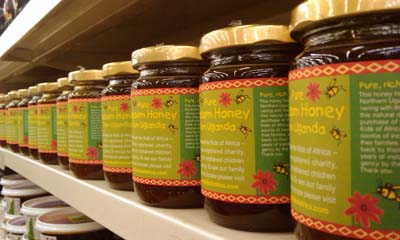
Kids of Africa honey well stocked up for this coming festive season.
-
Archives
- June 2011 (2)
- May 2011 (2)
- April 2011 (2)
- March 2011 (1)
- January 2011 (3)
- December 2010 (1)
- November 2010 (3)
- October 2010 (8)
- September 2010 (1)
- August 2010 (1)
- July 2010 (3)
- May 2010 (2)
-
Categories
-
RSS
Entries RSS
Comments RSS
